
It's also really not compatible with viewing on a phone due to the nature of the graphical displays, so your mileage may vary if trying to view on tiny screens.
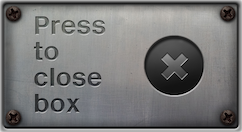

















Through a scouring of online image resources, various printed materials, and other sources, this page attempts to detail the numerous variations of Class 370 APT-P train formations known or believed to have operated over the class's lifetime. It also details the variations of cab front details that arose over the years (56 to date - not bad for just 7 cabs!), allowing the keen-eyed observer to identify otherwise unidentifiable units. I'm sure there are official records out there, but they're not immediately to hand, so enthusiasts' photos will have to do instead. 
Links to photos or other sources that have formed the basis of the information on this page are given where possible, all of which were current at the time of creation but can't be guaranteed over the long term. In addition, where photographic records are not currently available, particularly for some of the early and brief formations, information in other publications has been used to tentatively correlate known set formations with vehicle numbers, pending further documentary evidence.
My sincere gratitude and thanks to all the enthusiasts who recorded these trains in whatever detail, and subsequently published their images and recollections. If you think you can add to, or correct the record here, please get in touch!














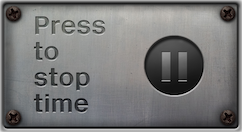
Forty-four APT-P (Advanced Passenger Train - Prototype) vehicles were built (45 if you include the pre-production trailer car, "Pilot") to seven different designs, and formed into six complete half-set units, listed here in formation order:
The minimum half-set trailer-car formation was DTS+TBF, and for the majority of units, these pairings remained consistent over time, with correctly-paired vehicles staying together (e.g. 48103 and 48603 from unit 370003) in the early years. Later, however, there were three swaps of TBF leading to some confusion over unit numbering, which will become apparent below. Although convention was for the Motor Brake vehicle in an electric multiple unit to define the unit number, with the APT-P, the Motor cars were treated more like locomotives and swapped around relatively frequently. There is reason to believe that the Trailer Brake vehicles were initially considered the set-number-defining vehicles in Class 370 half-sets, but this appears to have been short-lived. Therefore, for the purposes of clarity on this page, the leading Driving Trailer vehicle is used to define the unit number. In other words, vehicle 48103 leads unit 370003 and so on, thus for the brief period where 48106 carries the unit number 370002, it will still be found listed here under 370006.

In researching this page, a number of interesting findings emerged. For example, the first power car was initially outshopped with a slightly paler/bluer shade of grey on the upper bodywork. The first power car to receive the InterCityAPT brand logo had it applied to both sides for a year or so, while all the others had a BR arrow on one side. One unit briefly had the nose logo but no black mask around the windows, another had a white APT logo on the nose, and one had a 1986 red stripe that, at least for a time, didn't make it all the way around the front! Two of the seven driving cabs had their horn grilles mounted upside down, and finally, only one set is currently known to have run as a full six-car rake while retaining a full-yellow cab end.
From liveries to listings - it looks like no APT half-set ever ran with its full sequential complement of allocated trailer cars (i.e. 370004 never ran as 48104, 48204, 48404, 48304, 48504 and 48604 - sorry Hornby!). Only four units were formed into full 6-car trailer-sets (and only three of these have been noted in traffic so far), all of which had intermediate trailer cars with a variety of final digits. Of these four only one set managed to stay full-length for its entire career, all the others being reduced to two-car sets by 1983 or earlier.
Equally surprising is that the full 14-car formation (two six car half-sets and two power cars) that the 44 vehicles were built to allow, may only have happened a handful of times, and seemingly never in public service. As you might surmise, if the full length rakes were not all formed up, a number of intermediate trailer vehicles may never have run at all; with the information currently available, three trailers (2 x TU, 1 x TRBS) are not accounted for in any APT-P formations listed below, although it's possible some of the so-far speculative allocations shown below may turn out to be these vehicles instead of those shown, as more evidence arises. A further four trailers only seem to have run in commissioning rakes but never as part of operational APT sets.
Good question. On 22nd August 1984, when I was not even in my teens, I was lucky enough to ride on the APT from Preston to London and back. Performing faultlessly on both journeys, it left an impression on me that I've been unable to shake nearly 40 years on, as the ballast reared up on one side and sky filled the window on the other.
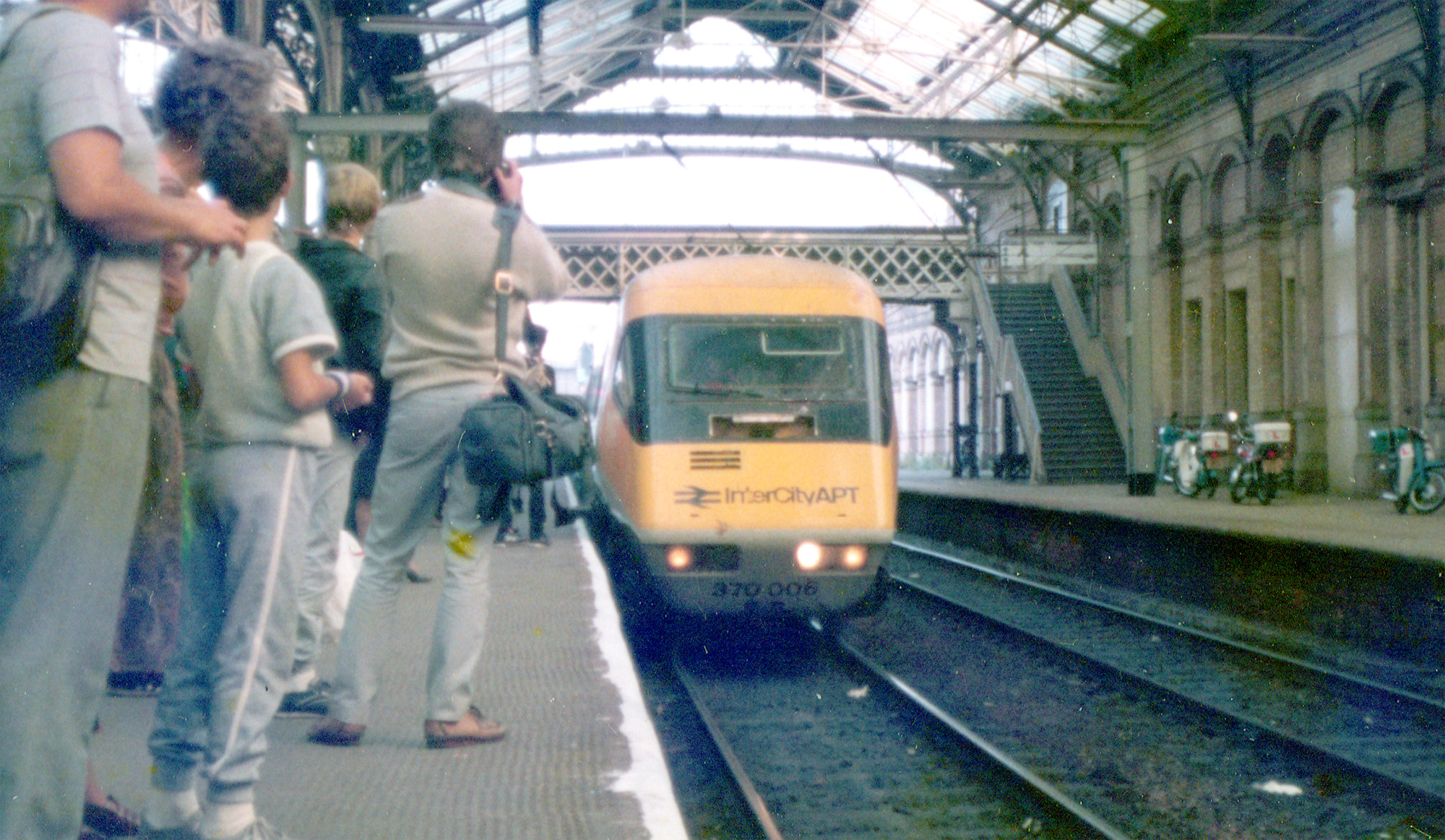
"This is a Staff Announcement: the APT is now approaching platform 6; the APT is now approaching platform 6." Well that gave the game away! 370006 leads 370007 into Preston on the morning of 22nd August 1984. The gaping hole where the lifting-mechanism cover should be must have messed up the aerodynamics! Other photos mere days before and after my journey show the flap back in place.
With the launch of Hornby's new OO-scale APT models in the early 2020s (one of which I received for a significant birthday in 2022!), and the lure of topping Shap Summit at 159mph in the Train Simulator APT-P add-on, I got to wondering whether I could establish the exact formation I'd travelled on in 1984. As I scoured the internet and various books for photos, I started noticing patterns among the pieces which, if you're me, you have to puzzle out and make fit into the larger jigsaw.
So perhaps this will be a useful reference for modellers wanting to build an authentic formation from their Hornby 1980 or 2020 models - similarly if you want to try your hand at the 155mph high-speed runs over Beattock in Train Simulator, dig through here and find out what you need to make a proper job of it. Or just reform with six power cars between four trailers and see where that gets you. 
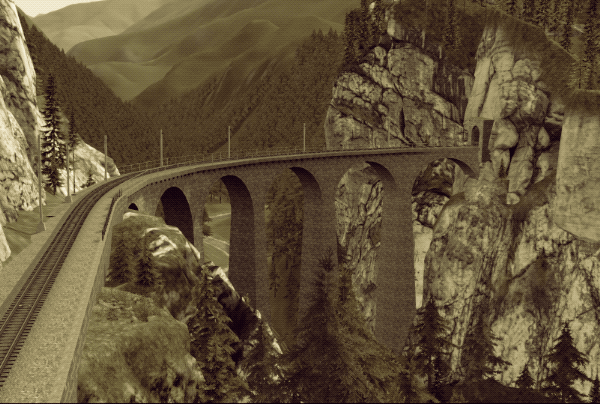
What do you mean, you don't remember when the APT was regauged and shipped to Switzerland?
Wherever possible, individual vehicle numbers are given for each formation, however obviously without very clear photos of each vehicle, or an accompanying record of vehicle numbers, there is often an element of uncertainty. Where a vehicle number is known or can be inferred with a high degree of confidence, it's shown in black. Where there is some uncertainty, it is shown in orange. Where it is entirely unknown, grey.
Power cars are generally shown as part of the set their pantographs are adjacent to - the one the knuckle is pointing at.
In each section, the featured unit is shown on the left/top, where there are two units in a formation, regardless of which unit is leading in any particular photograph (you can adjust the visibility of the second unit using the opacity slider). In service where two power cars were present, it was generally the practice to raise the rear-most pantograph, thus in the operational double-unit illustrations below, with a handful of exceptions, the second pantograph is shown raised, as if the featured unit is leading.
Where the unit is part of a test train or being hauled dead, the formation is shown with the leading vehicle on the left in the majority of cases. For example, if a unit is known to have been propelled by a diesel loco or power car, the unit will be on the left and the loco on the right; where hauled, the loco is on the left and the unit on the right. Generally speaking the illustrations below are based on the photographic evidence, which more often shows diesel-haulage than APT-leading, but of course many of these mixed combinations in test trains were reversible.
Dates in all sections are based on those reported in photographic or other evidence, and should only be taken as approximate, or as indicative of a rough minimum range. It's likely formations were around for periods before and after the dates shown, and as more evidence emerges, these dates will be revised accordingly.
While some photographers kept meticulous records, including vehicle numbers and dates, after 40-odd years it's understandable that not everyone (myself included) will have all the pertinent facts to hand when scanning old photos for upload, and "sometime in 1982" may be the best that can be offered, even if it was actually 1980. In addition, us humans are prone to real-time errors and may have inadvertently mis-recorded events as they happened - particularly when confronted with something as unusual as the APT. How many of us assumed that because the set number was 370006 that the power car would be 49006 (or vice versa?), or because we boarded vehicle 48504 we were on set 370004?
Similarly, old photographs and fading memories are often blurry or fuzzy, or passing at speed, leading to mis-identification of the subject. For this page I've attempted to cross-correlate as many sources as possible, looking for typos, and assessing for consistent and/or changing details in various vehicles with time (even down to paint scratches and bird-strikes in some cases - including finding the tell-tales of photoshopped touch-ups - yes you've been spotted!). In this way it has been possible to narrow down some of the more vague data, and make speculative corrections/guesses for dates, mis-identified units, and so on.
In trying to piece together this puzzle I've started out from a position that the photographer/note-taker is correct with their captions and dates, and only if strongly contradictory evidence emerges, or it becomes logically impossible to fit a particular claim with all the others, have I assumed that there may be a mistake. For example, if I come across a 1984 photo captioned "370004" showing a set at speed on the WCML, and no other images exist of 370004 in traffic in 1984 (to the contrary, it appears to have been heavily cannibalised at Derby by that time), then I have assumed a mis-identification or typo and attempted to identify the correct unit. Similarly, a photo labelled 370008 is going to raise questions (yes there is one out there!). Likewise, if a photo shows a red stripe around a unit's nose, but is dated 1984, I will assume that, because that livery modification appears only from 1986 in other dated photos, that it's a mis-remembered date.
A number of published works have been used as additional sources of background and specific information for this page, but again details have been assessed for consistency with other sources. As an example, one book describes the first APT run as a full 2+12 (6+2+6) rake, where photographs of the same run in another publication show it to be a 2+6 (3+2+3) formation (consistent with the only operational pair at the time). Similarly published photos of black-masked units operating in 1979 appear to contradict both the application of black masks (from mid-1980) and the introduction dates of the units shown in the photos (also 1980). Here additional evidence (such as other photos of the same formations) has been taken into account before assuming the published work must be correct.
Similar logic has been applied throughout the page where contradictory data has emerged, but as with any exercise of this kind, it's possible that new evidence may overturn any of these logical assumptions. Some of what's presented here is bound to be erroneous itself, and subject to update at any time (and frequently is - I too make typos!). Suffice to say that while I try to be as accurate as possible, you should rely on the information on this page at your own risk!
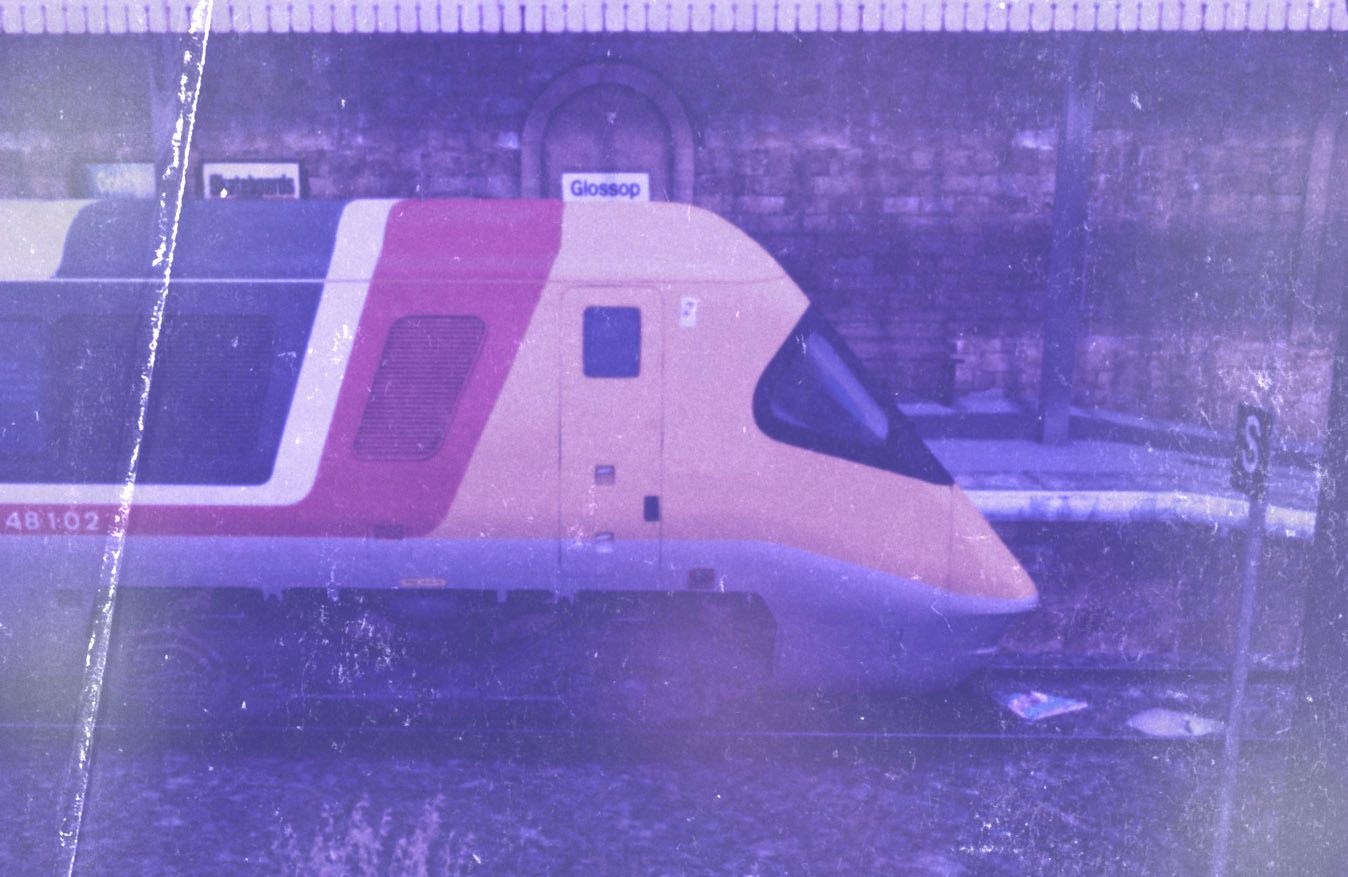
Some old photos may not be what they first seem.
The basic formations over time for each unit (not including power cars) are shown here as a summary. Much more detailed information about unit and power car combinations, the dates they operated, and livery modifications can be found in the individual unit sections below.
An animated sequence showing these progressions through time can be found down the page, in addition to common-formation guide to regularly sighted APT pairings, plus a summary of APT combinations that probably never happened.

















At present no evidence shows 002 in this formation paired with another unit - TRSB 48404 was later formed in set 003.


For 370002 in June and July 1983, see 370006 below.







At present no evidence shows 003 in this formation paired with another unit – TRSB 48401, which was moved to set 005, appears to have been removed from 003 before it was first paired with 004.











At present no evidence shows 004 in this formation paired with another unit – both trailer vehicles appear to have been removed before the set was first paired with 003.




















Briefly carried the set number 370002 in June and July 1983; restored to 370006 by August 1983.









The earliest sighting of 370001 so far discovered online is of a 3-car set outside the RTC on 13th August 1977 (1). The same set was later noted nearby on 27th February ahead of the public unveiling in June (2).
Sources: Hugh Searle Alistair Ness
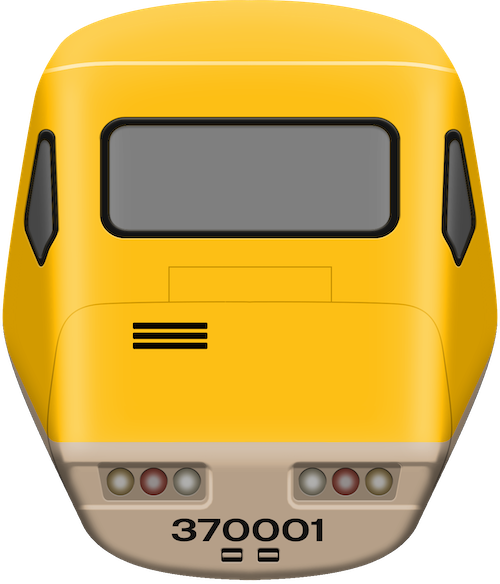

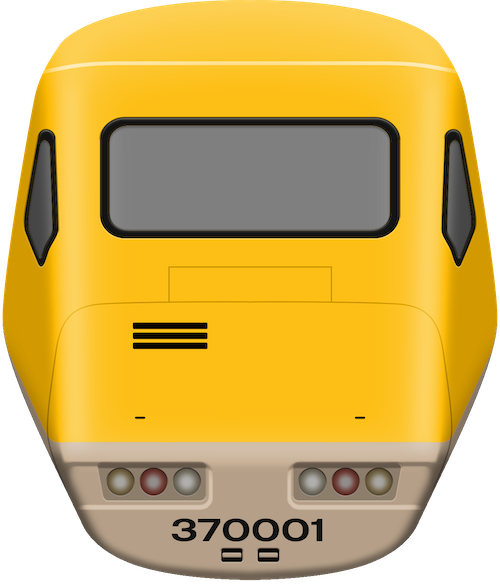
The earliest frontal view of 48101 comes from the public unveiling event at Derby in 1978. Specific details include the full yellow cab, black window frames, white cantrail stripe, and closely spaced, centrally placed '370001' numbers. There are not yet any slots in the nose cone above the light clusters, and the horn grille moulding is flush with the main nose moulding. The vehicle is last seen in this condition in August 1978.
Source: Colin J Marsden (apt-p.com)




The first APT-P formation to be revealed at the unveiling event at Derby in 1978 was formed of DTS 48101, a TS 48206, TBF 48601 and M 49003, identifiable by its 'City of Derby' nameplates. 49003 was also notable at this time for having the APT logo on both sides of the power car, presumably for publicity purposes as the vehicle's naming ceremony was performed on one side, but official photos of the rake were taken from the other. The side visible here would later carry the BR logo. Note also that the TBF doesn't have the 'first class' yellow stripe above the windows – this feature (or lack of) was common to the first four units, and retained by 48601 for its entire career.
Source: Colin J Marsden (apt-p.com)






A prototype for everything! A series of photos taken at Derby show brand new units 370001 and 370002 coupled nose-to-nose while undergoing attention, probably before either rake took to the main line. (The actual formation of 370002 is unknown, but likely to be that shown.) The date is speculative, but the cleanliness of both sets suggests neither has been let out at this time. Grey inter-car fabric shields can be seen between the vehicles, and 370001 appears to be in the process of being fitted out as the test rake, with workbenches replacing seats in some of the windows.
Source: John Walker (apt-p.com)





This is 'Trailer Rake 1' and all three vehicles were kitted out with test equipment for early running trials (1)(2). Initially these trials were HST-power-car-powered, but later progressed to running under electric power on the West Coast Main Line. For a time in 1978 the unit was seen with pale-coloured inter-car shields hiding the corridor connections (3), however these appear to have been removed again after a short time. 370001 would remain in this formation until around 1981.
After converstion to the test rake, a unique feature of TBF 48601 was the auxiliary generator located in the van area, with the destination indicator window on both sides replaced by a vent and an exhaust visible in the roof immediately above on the left side, usually surrounded by discoloured paintwork.
Sources: Lewis Bevan traintesting.com Johannes Smit


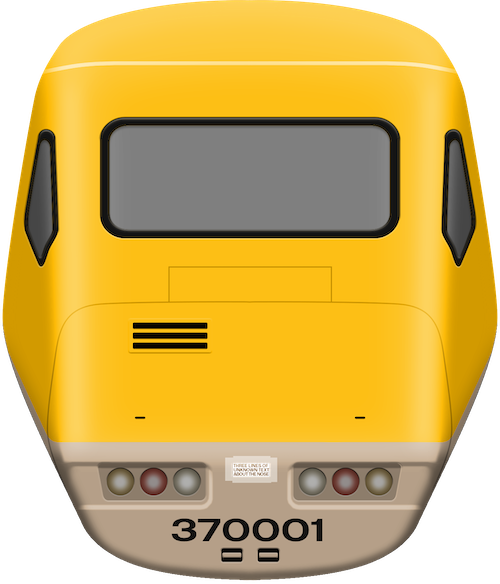
By September 1978 a minor change had been made, first seen at Shields Road Open Day, with short slots being opened on the top side of the nose, above the light clusters.
Feel free to time-travel back and forth to see the changes by tapping or hovering over the clocks under the cab front image – or compare with other units around the same time by hovering or tapping the cab front graphic.
Sources: spannerman37025 In Advanced Passenger Train; The official illustrated account of British Rail's revolutionary new 155mph train






The set appeared in public at the Sheilds Road open day in September 1978, with 49003, Test Service Car 1 and W43001.
Source: GregBee







The first powered APT-P run took place from Glasgow Shields Road depot on 26th April 1979, comprising units 001 and 002 with power car 49003.
Source: In Advanced Passenger Train; The official illustrated account of British Rail's revolutionary new 155mph train


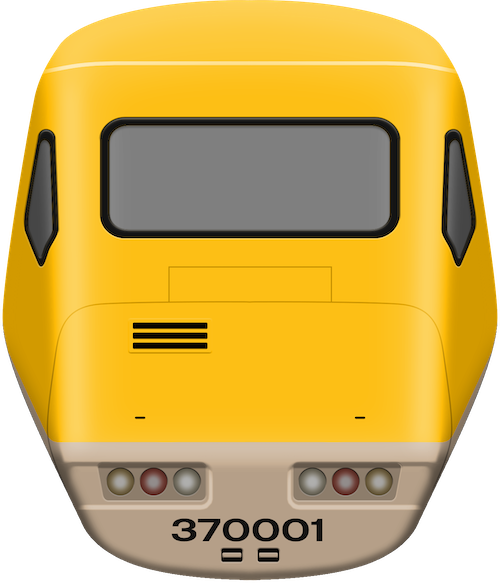
Sometime after the first powered run, a crudely applied sticker, held on with duct tape becomes apparent on the nose between the light cluster. It had three lines of text, and presumably related to the correct opening of the nose cone for access to the coupling gear inside. Units 370001-370004 each had a variation of this sticker, but with subtly different placements, so if you can't make out the unit number in your blurry photo, maybe the duct tape will give it away. Also visible in some images is the horn grille becoming slightly raised from the nose cone.
Source: Gordon Woods








By July 1979, main line testing was underway between Glasgow and Carlisle, paired with three-car 370002 and two un-branded power cars.
Sources: M Featherstone, in Modern Locomotives Illustrated No. 167 by Colin J. Marsden Gordon Woods Richard Priestly







A curious formation noted at Glasgow Shields Road depot on the occasion of a visit by the Institution of Civil Engineers: 370001, one unbranded power car, and the TBF and TS (presumably) of 370002 on display.
Source: beqi






Another unusual formation spotted in late 1979 or early 1980, according to the caption, shows both prototype HST power cars hauling 370001 and a single power car (complete with oil tail lamp). In one view, test cabling can be seen connecting the rear HST power car and 001's cab, taped between the cab side windows.
Source: MrRatty








A photo dated 1980 features two unbranded powercars once again. On 20th December 1979, sets 001 and 002 broke the British rail speed record, reaching 162.2mph near Quintinshill, holding the record until beaten by a Eurostar running at 208mph on dedicated high speed tracks in 2003. The formation would have been something like this, though power cars and branding are unknown at this time!
Source: walkerworkz


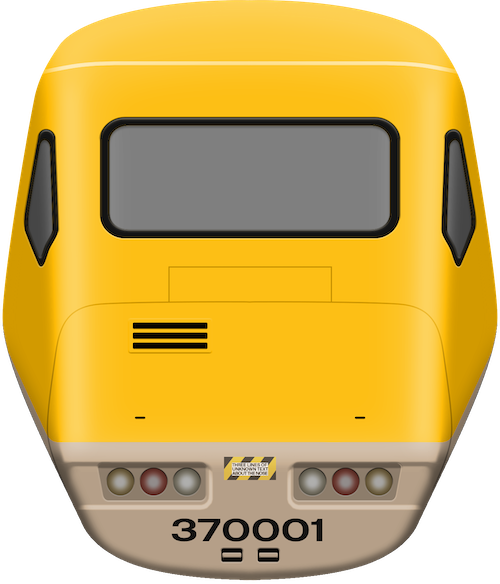
The nose sticker had already mostly peeled off by the end of 1979 and the sticky residue had been removed by January.
Source: Jerry Glover








By January the 001-002 pairing was running with a pair of fully branded power cars.
Source: Gerry Glover








An unfortunate incident near Lockerbie with a lost pantograph carbon strip involved the pair along with power car 49001 and another unidentified. The pair was later rescued by a Class 87.
Source: walkerworkz image series


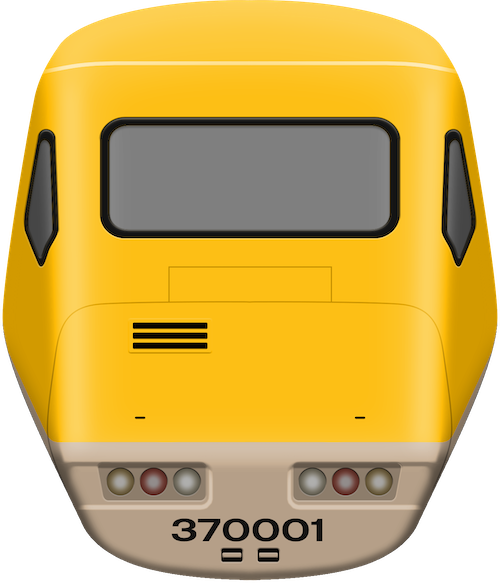
To be annoying, a replacement sticker, this time held on with striped warning tape, was added by February.
Source: maljoe







Test runs and moves from the WCML to and from Derby for attention were often in the company of prototype HST power cars W43000 and W43001. An example of such a move was recorded at Crewe and includes both HST power cars, Test Service Car 9, unbranded power car 49002 and the three cars of 370001.
Source: Lewis Bevan




Probably sometime in February, going by the nose-end sticker, 370001 was back at Derby in the hands of 45058. The image doesn't show whether a power car or barrier vehicle were present.
Source: Jon Stein










With the first full-length half-set, 370005, and one power car, this pairing was undertaking a VIP run from Glasgow on 18th April 1980 when an axle between TS 48203 and TRSB 48401 of unit 005 failed, derailing at speed near Yealand. The train remained upright and was able to be moved to Carnforth. A number of photos of this incident can be found in the Gallery pages at apt-p.com (2), plus an account on the Carnforth Station website (1). Power car 49006 was noted on an RCTS image of the unit prior to the derailment. (3)






By July of 1980 the set was paired with two cars of 370004 and power car 49001, for trials of the first Brecknell-Willis High-Speed pantograph fitted to an APT-P (which was initially painted blue, as opposed the grey of all subsequent Brecknell-Willis fitments). Photos show the presence of 48206 and the dodgy tilt of 48601 which is visible in other photos of 370001 around the time. This suggests that the handful of photos captioned as 370005, which was running as a six-car set and with black window surrounds at this time, are likely to have been mis-labelled.
Sources: Hugh Ballantyne, in Modern Locomotives Illustrated No. 167 by Colin J. Marsden Peter's Rail Pictures image series D Kimber, in Modern Locomotives Illustrated No. 167 by Colin J. Marsden






Two images dated August 1980 show the same trailer set pairing, but with a regular two-stage Stone-Faiveley fitted power car. At present it's unclear whether this was 49001 with its original pantograph refitted, or another power car standing in temporarily.
Source: George Staddon collection






The same pairing was found parked inside Crewe Carriage Shed in a further series of images dated circa 1981. Although this pairing with the High-Speed pantograph power car has been reported as late as 1982, it is currently thought that this date is erroneous. Power car 49001 was noted inside Derby under overhaul in May 1981, and by 1982 370001 had been repainted and reduced to two cars.
Source: Peter's Rail Pictures
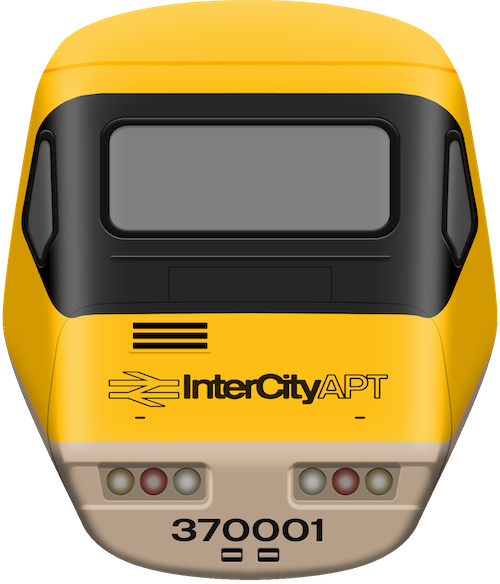

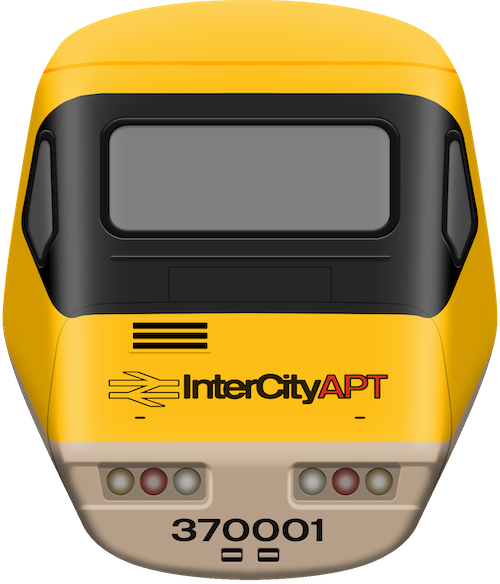
Not the first to wear a mask and APT branding on the nose, but the first, along with 48102, to be fitted with an under-windscreen rain strip, presumably to stop excess water from rushing up the nose during rain at high speed! 48101's black window surround extends further above the cab windscreen than any of the other units, making it easy to identify, easily a couple of inches further than the next highest, 002 or 003. It also features a slight droop on both lower corner curves when seen directly from the front. For the rivet counters, the rainstrip on 48101 was fitted lower down the nose than on any of the other Driving Trailers, being attached just above the top of the folding flap above the nose cone. All the others were fitted just below the seam line above, directly under the windscreen and wiper mount.

Source: British Rail 1980s and 1990s









In the run up to the public launch of services, 370001 next appears in September 1981, wearing a mask, shortened to 2 cars was paired with full length unit 370007 and power car 49002 (1). On 20th September the same pair appeared at Old Oak Common open day (2).
Sources: Frank Struben HSTDaniel20









The following month 001 was paired with power car 49006 and 370006. It was recorded at Preston on 23rd (1) and 29th November (2). Additionally this set is featured in the BBC Horizon documentary 'Race Against Time' broadcast in December 1981 which charts the unit between 19th and 23rd October (with thanks to Adrian Wheeler for the tip-off!). Some images also depict what may be the same unit failed at Beattock (3).





In February 1982 001 was paired once again with 370002. The power car was noted as 49002.
Source: British Rail 1980s and 1990s
At the end of November 1982, axle problems forced the withdrawal of all APT-P sets while checks were carried out. Axle rectification and modifications to passenger doors took until May 1983, and it looks like pretty much the whole fleet returned to Derby during this period. As these modifications were taking place, the APT test and development programme as a whole was simplified, and any vehicles not required for the reduced operation were set aside for cannibalisation. One consequence of these changes was that some shuffling of vehicles took place, resulting in 370002, 370005 and 370006 exchanging TBF vehicles.




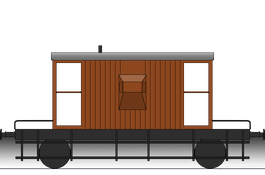
Just to show that something happened in 1983, a movement between Crewe and Derby saw 370001 hauled by 31259.
Source: hydey44

In December 1983, DTS 48101 was recorded in the storage lines at Derby on accommodation bogies, looking a little forlorn. Presumably work was in progress with TBF 48601 in preparation for operation with upcoming newly converted, non-articulated car 48204 (see below).






In March 1984, TS number 48204 was modified at the Railway Technical Centre to be an unarticulated vehicle mounted on two independent bogies rather than sharing with adjacent vehicles. Given the number RDB977527 (though this was never carried in traffic), it was marshalled between the TBF 48601 and power car 49005, both of which were fitted with bar couplers for this purpose, as opposed to the usual tightlock/buckeye style previously carried. This meant that 48204 always operated with 370001 and 49005, as the couplings were unique, and power for the test equipment was routed from the auxiliary generator in 48601. An undated record of the set at the Old Dalby test track is presumed to be very early in the vehicle's testing program.
Source: Martin Richmond







From at least late June of 1984, the modified TS 48204 and 370001 were paired with 370002.
Source: Jim Nisbet


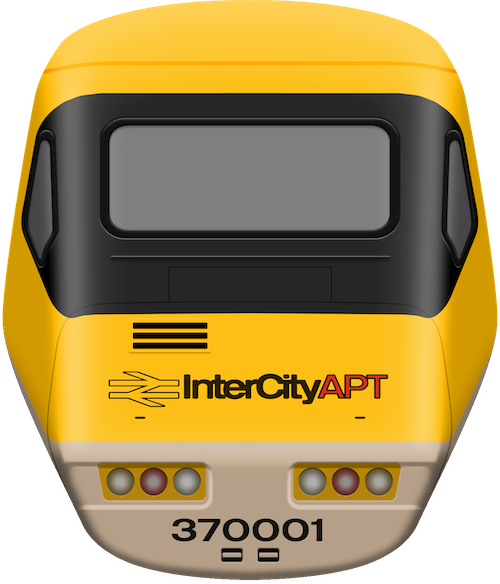
By August 1984, a repaint from its somewhat scuffed 1983 appearance added a minor livery modification to 48101's nose end, with the 'APT' outline letters filled with red.

Sources: Graham Williams David Rostance







The same formation was still in operation in August of 1984, with powercars 49002 and 49005. This formation continued in operation until October, although it's not certain whether the power car combination remained the same throughout. Thanks to Alistair Lees for sending an observation of this set on 31st October.
Source: Graham Williams


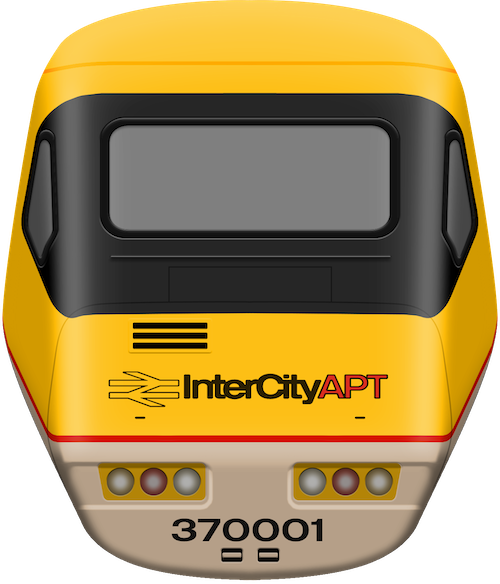
In March 1985, 48101 could be found back at Derby, with a minor change of appearance. Its light clusters now featured a yellow background in place of the previous grey – possibly new replacement units moulded in yellow but not painted?
Source: Haydon Walker




By March 1985, and without the modified TS 48204, the remaining two cars of 370001 plus power car 49005 could be found at Derby, coupled to Test Service Car 8.
Source: Haydon Walker







On 4th July 47189 hauled 370001 and 49005 through Clay Cross, presumably for recommissioning or returning them to the wires. 49005 has been fitted with an observation pod on the roof, in connection with further pantograph trials (see below).
Source: Ian Purkess







Once under the wires, 001 and 002 were again paired for pantograph testing using 49005.
Source: Richard Hobson (apt-p.com)






Towards the end of the month the set was running without 49002 in the consist. 49005's observation pod can be seen clearly on the roof (2) and has instrumentation cables strapped to the pantograph. Thanks to Simon Argyle for the eagle-eyed spot of the observation dome.
Sources: Hugh Searle Hugh Searle








A few days later 49005 had been stripped of test equipment and pod, and 370001 was reformed with 370003 and 49002 in the consist.
Sources: Steven Allen Hugh Searle image series






Towards the end of 1985, 370001 is partnered by 370006 on the TS 48204 test train noted on Shap.
Source: Peter








Paired again with 370003 the pair continue to operate test trains with TS 48204.
Source: Graham Knott



The final change to 48101's appearance came in early 1986, with the application of a red stripe around the nose at the divide between yellow and grey. This was common to the operational units at Crewe during the final year or so of testing. The earliest record so far is from 19th February.
Sources: Serendipity Images Yorkshire Rover








By March 1986, 370001 has gained a red stripe around the cab, as applied to all the operational units during the final year or so of testing (1). One of the last dates that 370001 is known to have operated is 2nd April 1986, where the unit was seen at Crewe with a decidedly dodgy tilt on the TBF (again) (2).
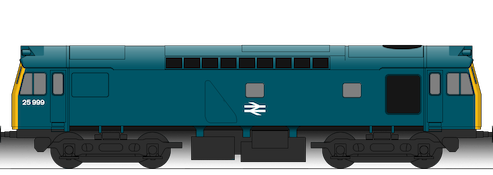




The same tilt issue can be seen in an image of the unit being hauled by a Class 25, possibly to Derby for the last time (1), assumed to be taken shortly after the above sighting (one source suggests 25138 as the traction, however this loco had been withdrawn in 1983). Further evidence shows the unit at Derby in late April with 25190 in attendance on 29th.
Sources: Dave Bowman Mick Morris (apt-p.com)





The set was noted stored at Derby by the end of May (1). In June the other vehicle from the set, 48204, plus power car 49005 were outside the RTC (2). The unit was noted as a two-car set and also coupled to 48204 and 49005 at different times during this period.


48101 and 48601 were broken up in 1987 at Derby Litchurch Lane, recognisable by the red nose stripe on the DTS cabside and the lack of yellow first class stripe on the TBF. 49005 is behind the pair.
Source: WesternSunset
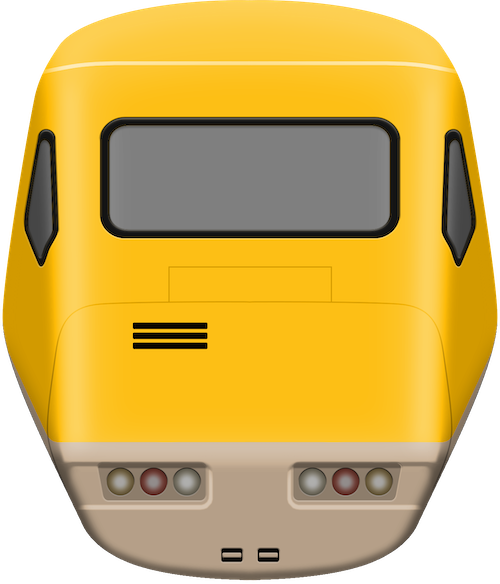

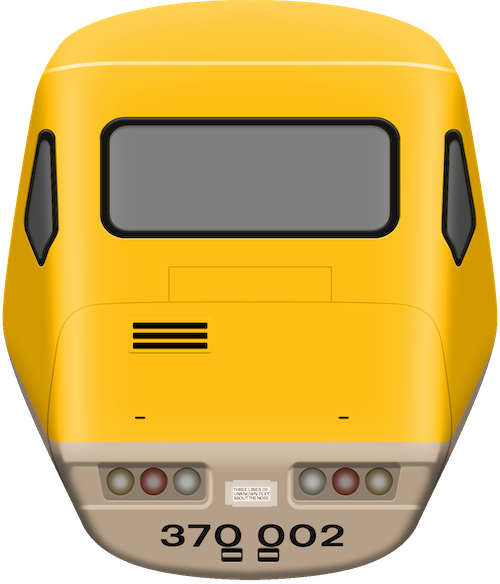
48102 presented a very blank face at its first appearance, at an Open Day at Derby Works. Like 48101, 48102 also appeared without the small slots on the top of the nose, and for this event, no unit number under the nose. Again, black window frames and a very smooth finish around the horn grille.
Source: Hugh Searle



370002's first appearance at Derby Works saw it formed with DTS 48102, one intermediate trailer, TS 48202 and TBF 48602. This was the only Class 370 that ran as more than a two-car unit with all vehicles numbered for the unit, albeit only as a three-car set at this time! Like other early TBF vehicles, 48602 does not carry a yellow 'first class' stripe above the windows at this time. The set can be distinguished from 370001 by the lack of an exhaust port on the roof of TBF 48602 and a regular destination window on its left side.
Source: Hugh Searle






A prototype for everything! A series of photos taken at Derby show brand new units 370002 and 370001 coupled nose-to-nose while undergoing attention, probably before either rake took to the main line. (The actual formation of 370002 is unknown, but likely to be that shown.) The date is speculative, but the cleanliness of both sets suggests neither has been let out at this time.
Source: John Walker (apt-p.com)


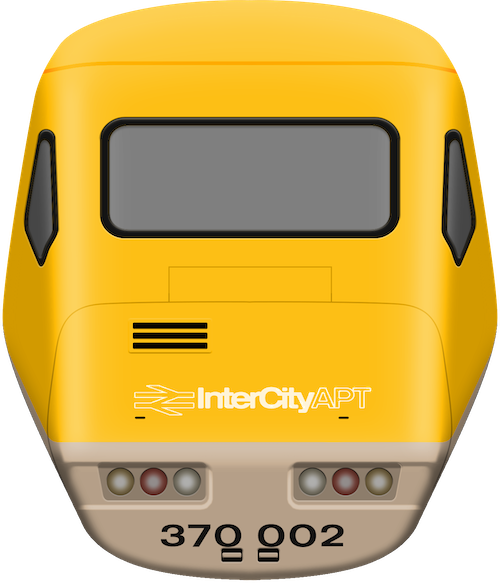
The next time 48102 becomes visible, in mid 1979, it has a unit number with very widely spaced numbers placed very low down, almost touching the nose-cone handle recesses. It has also received a duct-tape sticker probably related to the opening of the nose-cone doors, similar to that on 48101, but positioned a little lower down under the point of the nose. Unsurprisingly, this was lost later in the year, leaving a sticky-tape scar. It has also had the two small slots opened on the top side of the nose, above the light clusters. A rivet-counter detail here is that the leftmost slot, as you look directly at the cab, is in the standard position, slightly outboard of the left hand tail light, while the rightmost slot is slightly further inboard, almost directly above the rightmost tail light, making this nose cone unique – and traceable, as we'll see later.
Source: David Russon







The first powered APT-P run took place from Glasgow Shields Road depot on 26th April 1979, comprising units 001 and 002 with power car 49003.
Source: In Advanced Passenger Train; The official illustrated account of British Rail's revolutionary new 155mph train








By July 1979, main line testing was underway between Glasgow and Carlisle, paired with three-car 370001 and two un-branded power cars.
Sources: M Featherstone, in Modern Locomotives Illustrated No. 167 by Colin J. Marsden Tom Noble, in Modern Locomotives Illustrated No. 167 by Colin J. Marsden








Later in the year, on the occasion of a failure of the set at Preston in October 1979, the two units had been paired with fully branded power cars. During testing with 370001, TBF 48602 had its destination indicator window on the right hand side removed, possibly for additional ventilation to the van area. Two months later, on 20th December 1979, sets 001 and 002 broke the British rail speed record, reaching 162.2mph near Quintinshill, holding the record until beaten by a Eurostar running at 208mph on dedicated high speed tracks in 2003. The formation would have been something like this, though power cars and branding are unknown at this time!
Source: Colin Whitfield image series








An unfortunate incident near Lockerbie with a lost pantograph carbon strip involved the pair along with power car 49001 and another unidentified.
Source: walkerworkz image series


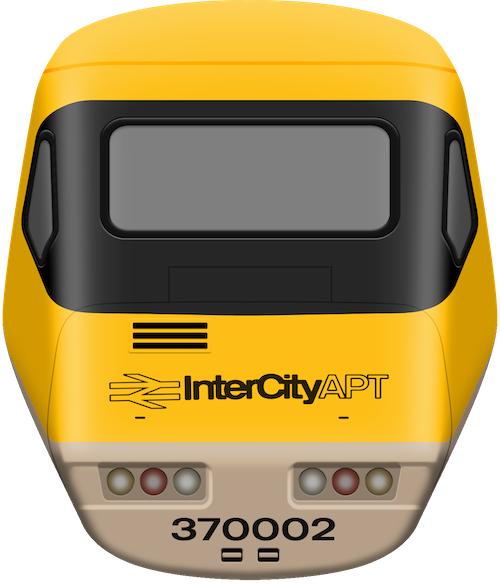
A unique variation was noted at Derby Works in June 1980, while 48102 was undergoing refurbishment, with the addition of white InterCityAPT branding to the nose top. This would not last into traffic, as 48102 would return with black window surrounds and black branding.
Feel free to time-travel back and forth to see the changes by tapping or hovering over the clocks under the cab front image – or compare with other units around the same time by hovering or tapping the cab front graphic.

Source: Haydon Walker



By May 1980, the set was noted back at Derby undergoing refurbishment and extension to a full length rake. Mounted on accommodation bogies (1), 48102 and 48202 were noted in June receiving attention with a TRSB vehicle, likely to be 48404 (2).


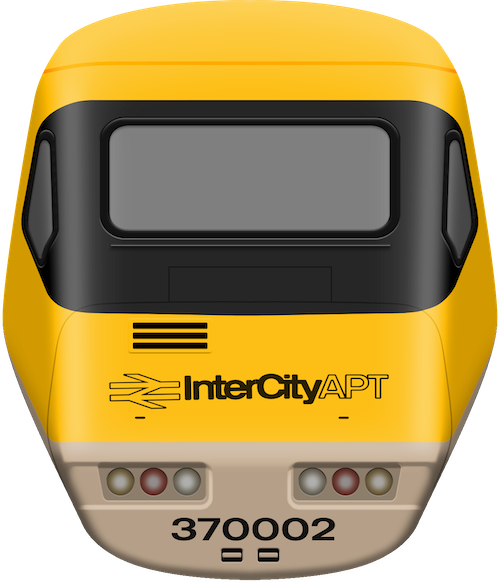
Fresh from a repaint, 48102 gained a black mask window surround and black branding on the nose top. The unit number is now closely-spaced and centred in the under-nose space. The APT logo appears to be very slightly skewed downwards from the horizontal on the left of the 'C in InterCity'. The mask reaches quite high over the top of the windscreen – not as high as 48101, but higher than any of the other units. The bottom edge of the mask curves smoothly around at the bottom corners, and is very slightly lower down the nose at the mid-point than at the sides.

Source: Colin Burnham








In 1980, 370002 was extended to a full-length six-car rake (as was the plan for the first four units at the time), noted being hauled past Toton by W43000. The numbers of the intermediate vehicles are based on entries in one of my own spotting books, having seen the rake at Crewe Works in 1981 (see below) – and making an assumption that the formation was not modified prior to that occasion. Nevertheless it's reasonable to assume that the TBF was 48602, and the TS is 48202, seen with 48102 in the overhaul photos previously listed. Of note is that 48404 later moved to set 370003. Following refurbishment, TBF 48602 was given its first class yellow stripe. There is currently no firm evidence to show the set operating in this form paired with another set.
Source: Colin Burnham


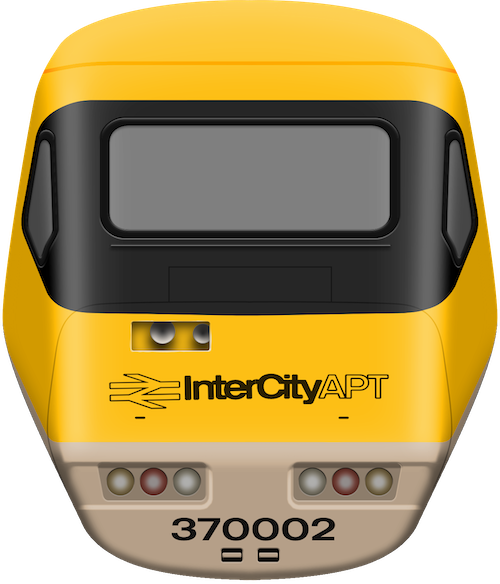
By June 1981 it had also been fitted with a rain strip directly under the windscreen.
Sources: Gray Callaway Paul Knight






370002's next appearance in the digital record is at Crewe Works open day in June 1981, where it appeared again in full length form. This was the last time in the current record where the unit has more than two vehicles.
Source: Gray Callaway










370002 as a two car formation had the dubious honour of being the short end of the infamous service launch train in December 1981, running from Euston to Glasgow and return, and falling foul of some travel-sick members of the press and then some bad weather. It was paired with full-length 370006.
Source: 74009












Unfortunately some seriously bad weather over the next couple of days brought the network to a halt, with the APT's southbound run on 9th December being curtailed at Crewe. A couple of days later, the set was recorded heading north with a Class 40 for traction, but with 85006 on the back, pantograph raised, apparently providing brake force. (This formation is shown in reverse order, with the leading loco on the right.)
Source: Alan Taylor


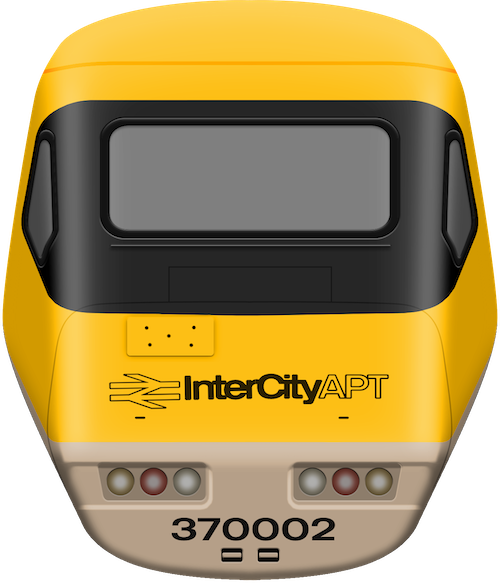
The final consequence of the horn grilles moulding working loose is seen here on 48102. It ran briefly in February 1982 in this condition before the hole was plated over.
Source: Arnie Furness





Briefly, in February 1982 the unit was once again paired with 370001. The power car was noted elsewhere as 49002.
Source: Arnie Furness


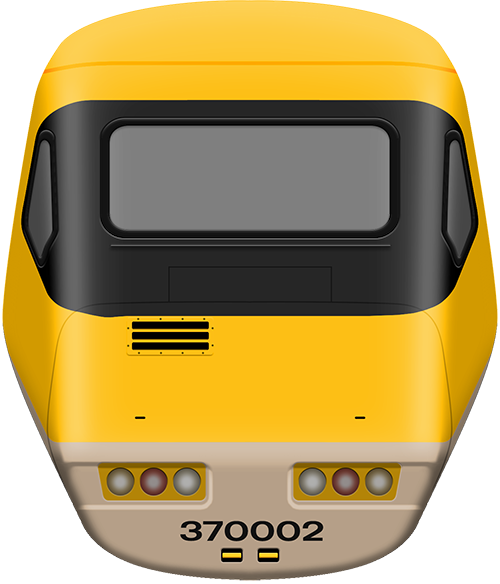
Between March and August 1982, 48102's missing horn grille was covered with a crude plate with five holes drilled through it. Not to be confused with 48107 which also had a plate fitted, but with eight holes through it!
Source: Colin Whitfield










Between March and October 1982, 002 was reunited with full-length unit 006, operating with a variety of power car combinations. The set was noted at Hest Bank with power cars still fitted with Stone-Faiveley pantographs.
Source: Colin Whitfield image series










For the detail-minded, the changeover between white and orange cantrail stripes on power cars was going on during this period!











Something went wrong on 14th April! The set was rescued from Nuneaton by 47350.
Source: Phil Lindsay (apt-p.com)









From June to August 1982, the pair ran with a single power car, 49003, easily identifiable by its nameplate.
Source: Antony Guppy









Sometime in the summer of 1982 (going by vegetation, paint chips and other tell-tale signs), 370002 was paired with 370007, and pictured in the Wembley area.
Sources: Neil Heaton (apt-p.com) Diesel Image Gallery (apt-p.com)










By October, 002 was once again paired with 006, and 49003 (now fitted with a Brecknell-Willis high-speed pantograph) had been joined by 49005.
Sources: steam60163 Andrew McConnell






The following month 002 was sighted at Carstairs with recently-shortened 370005. This is the last presently-known sighting with its original nose cone.
Source: Gary Thornton
At the end of November 1982, axle problems forced the withdrawal of all APT-P sets while checks were carried out. Axle rectification and modifications to passenger doors took until May 1983, and it looks like pretty much the whole fleet returned to Derby during this period. As these modifications were taking place, the APT test and development programme as a whole was simplified, and any vehicles not required for the reduced operation were set aside for cannibalisation. One consequence of these changes was that some shuffling of vehicles took place, resulting in 370002, 370005 and 370006 exchanging TBF vehicles.
For 370002 between June and August 1983, see 370006!



After 1982 things get a little confusing. In mid 1983, 48106 spends some time running around with '370002' on its nose, and later in 1983, 370005 is running around with '370002' clearly visible under its unit number, 370002 gets a completely new nose, and 370004 loses it's nose! So what was going on and will the real 370002 please stand up? The evidence suggests that units 370002, 370005 and 370006 had a three-way swap of their DTS/TBF pairings, with 48102 joining with 48605, 48105 inheriting 48606, and 48106 picking up 48602. Consequently 48106 was given the unit number 370002 shortly after returning to traffic, perhaps following the convention of EMU brake vehicles defining the set number, however this was short-lived and reverted to carrying 370006 within a couple of months, while retaining new partner 48602. In the meantime, 48102 donated its nose cone to 48105 in 1983. It received a replacement by the time it was next recorded in traffic a year later, in April 1984, possibly from 48104 which is known to have lost its nose by this date. So in a peculiar way, all four units became 370002 in some respect or other!
Of note, the new nose cone did not receive the APT branding, and the lower edge of the black window mask was somewhat uneven, with a noticeable downward droop in its lower edge left of the horn grille. The replacement nose cone also came fitted with yellow coloured light clusters, symmetrical small slots above the light clusters (when compared to 002's unique original asymmetrical arrangement), and a rivetted horn grille.
Source: Sean Lancastle





In May 1983, 48106 from 370006 was paired with 370002's former TBF, 48602. Shortly afterwards 48106 had its unit number adjusted to 370002 for a short period in mid-1983 before reverting to 370006. When 48102 returned to service in 1984 (running as 370002) it was paired with 48605 (48105 had been paired with 48606) completing a three-way swap.
The first re-appearance of the 'real' 370002 (with a new nose cone) is in April 1984, paired with another two car set (not 370001 as the TBF has its first class stripe). Speculatively this is 370005 which was seen active in a similar formation around the same time.
Source: Sean Lancastle






Starting a month later, in May 1984, 002 was paired with 370003 for a couple of months.
Source: Pete Wilcox






The same pair appeared at Crewe Works Open Day on 22nd June with 48605 in the formation, confirming the TBF swap.
Sources: Haydon Walker Railtec Models







From late June, 002 was once again paired with 370001 forming a test train with modified TS 48204 in the consist. This coach had been rebuilt in March 1984 as a non-articulated vehicle, fitted with two end bogies and marshalled between 48601 and the power cars.
Source: Shawford Junction – Mark Bugler







Thanks to the capturing of a vision of the future (two APTs in adjacent platforms) at Preston in August 1984 (1), it's possible to confirm that 49002 and 49005 were the powercar pair at the time. The same power cars can be seen in a selection of images thought to have been taken around the same time on test (2). The same formation continued to operate until late in the year, with the last photo date being 26th October, and the latest observation date 31st October (thanks to Alistair Lees).
Sources: Haydon Walker R Hobson (apt-p.com)





370002 is next sighted in early 1985, probably paired with 370005 (certainly from April). The set was recorded as comprising 48102 and 48605, reaffirming the three-way TBF swap, with DTS 48105 and TBF 48606 also in the consist.
Sources: R Collen-Jones Simeon Gaskell Hugh Searle







In July, 002 was again paired with 001 for pantograph testing. Of note 49005 has been fitted with an observation pod on the roof (2) and has instrumentation cables strapped to the pantograph. Thanks to Simon Argyle for the eagle-eyed spot of the observation dome.
Source: Richard Hobson (apt-p.com)






Around the end of July the set had lost 49002. This is the last currently known operational record of 370002, the set being used for spares at Crewe Electric by November.
Sources: Hugh Searle Hugh Searle





The 002/005 pairing made an appearance at Wolverton Works open day on 17th August: probably the last public appearance of either set.
Source: Mark Beal


Following the visit to Wolverton, 370002 was next visible stored at Crewe ETD in November.
Source: Hugh Searle










The final formation was an incongruous pairing with full-length 370007 and power cars 49001 and a now nameless 49003 (both facing the same way) for a one-way trip to Rotherham for scrapping. Thanks to Paul Sweetland for a correction on this formation!
Source: Nigel Curtis (apt-p.com)


In its final moments, 370002 became a media sensation for the second time (its first time being as part of the passenger launch train in 1981), as the press had a field day reporting on the scrapping of the APT at C.F. Booth's in Rotherham.
Source: John Turner image series
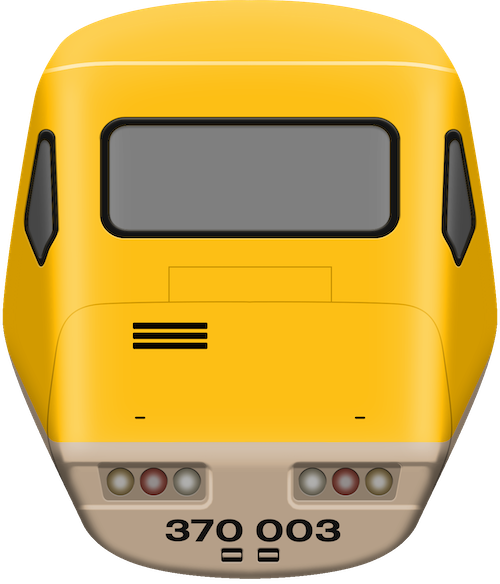

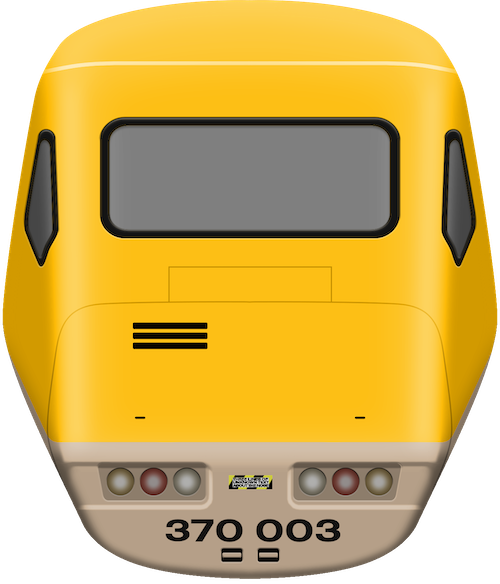
When 48103 first appeared around April 1979, it had the standard full yellow end and black window frames that featured on all other members of the class when new. Unlike the first two units, the small nose-top slots were present from at least the first available photo. Widely spaced unit numbers were centred in the under-nose space, unlike 370002's lower position.
Source: jetty - buns in black








The earliest-dated photo of 370003 currently discovered is 23rd April 1979 at Preston, operating under electric power but with prototype HST power car W43000 and Test Service Car 9 forming the other end of the set (1). This was the longest set to run at the time, comprising five trailers and an unbranded power car. The trailers were DTS 48103, probably TS 48204 (as noted in the set the following year), TRSB 48401 (shown as allocated to the set in the 1980 RCTS Coaching Stock book, and also visible in a BTF film – see below – of note is that this vehicle was formed in 370005 by April 1980), probably TF 48501 (also part of the set the following year), and TBF 48603. Other images show what is believed to be the same formation at Crewe (2) and Lancaster (3) respectively, though the date of 1981 on the latter is thought to be inaccurate.


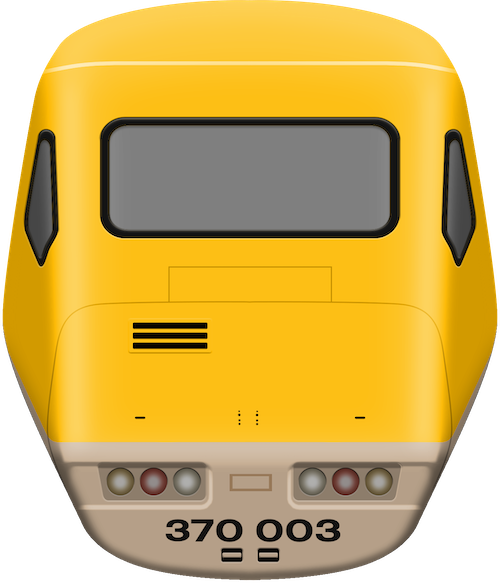
Within a very short space of time, around the end of April or May 1979, a crude sticker had been applied to the nose end, using chevron warning tape, presumably about the operation of the nose cone. On 48103 this was neatly positioned between the lights, and roughly in line with the light clusters.
Feel free to time-travel back and forth to see the changes by tapping or hovering over the clocks under the cab front image – or compare with other units around the same time by hovering or tapping the cab front graphic.
Source: Colin Whitfield








What is believed to be the same set, albeit with a different HST power car, was noted passing Duffield on 1st June. Of note is that none of the vehicles carry yellow first class or red buffet car stripes above the windows. 370003 also features in a British Transport Films clip from 1979 as a five car set, which shows a close up of 48401 in the rake.
Sources: John Wooley Ruairidh MacVeigh (British Transport Films clip)







Reduced to four cars and paired with a two-car 370004 by November 1979, an undated record shows the two sets together with power car 49003 still wearing its wrong-side APT logo. This was rectified by mid 1980.
Source: Andy Beeley


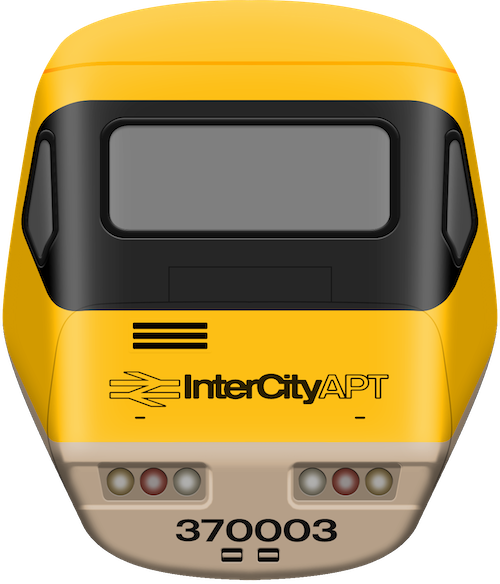
By early 1980 the sticker had been lost, but the sticky residue from the tape left a long-lasting mark where it had once been. Remnants remained visible as late as June 1980. Also visible at this time were a series of holes just above the nose in the middle, similar to those on 48104, presumably from mounting of test equipment at some earlier point. These are clearly visible in some images, though appear to be filled in later images.
Sources: RailPhotoPrints Roy Jackson







The pairing, first noted from the 003 end in February 1980 (1) undertook many test runs over the next few months, until June 1980. One notable movement was the pair's participation in the Rainhill Cavalcade on 24th and 25th May 1980, propelled by 56077, after which it immediately resumed main line testing (2).
Sources: Dave Felton Haydon Walker


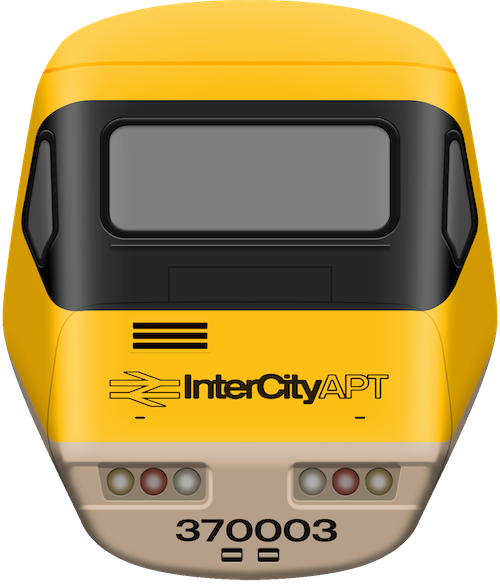
Disappearing for a year or so, by August 1981, 48103 could be found fully masked-up in the works yard at Derby. The black window surround extends a few inches above the window frame, but not as high as that on 48102. The mask's lower edge curves in smoothly, with only the smallest of droops on the lower corners, and runs very straight across the top of the nose cone. No rain strip is yet fitted below the windscreen. New running numbers are closely-spaced and positioned slightly off-centre to the right when facing the front.

Source: The Cycling Signalman






370003 drops off the digital record for a period in mid 1980. At this time, the plan was to extend 003 and 004 to full length rakes. When DTS 48103 was next noted at Derby in August 1981, complete with black window surround and on accommodation bogies, it was in the company of what could have been its intended full-length rake. Suffice to say that the plans slipped as fleet modifications were made, and 003 did not return to traffic with this full complement of trailer cars. The slightly weathered appearance suggests it had been left in the elements for some time in its new livery.
At present there is no indication what the trailers were numbered, however assuming the set was assembled in late 1980, vehicle allocations from the 1981 RCTS Coaching Stock book allow some speculation about their identities:
Source: The Cycling Signalman
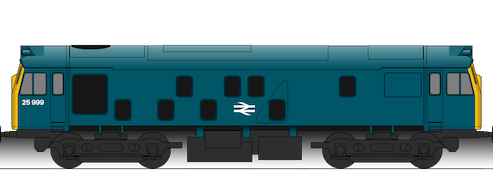




When next sighted in March 1982, 370003 was at Sheffield being hauled by a Class 25, and in a three-car formation with TRSB 48404 (previously in 002) between the DTS and TBF. It would retain this formation for the rest of its career – and beyond! Worth noting that the TBF never received its yellow 'first class' stripe above the windows, in common with 48601 in 370001.
Source: roger5450



Again the set seems to have dropped off the record for a few months, reappearing in September having been buffed up for Derby Works Open Day.
Source: Nick Leverton
At the end of November 1982, axle problems forced the withdrawal of all APT-P sets while checks were carried out. Axle rectification and modifications to passenger doors took until May 1983, and it looks like pretty much the whole fleet returned to Derby during this period. As these modifications were taking place, the APT test and development programme as a whole was simplified, and any vehicles not required for the reduced operation were set aside for cannibalisation. One consequence of these changes was that some shuffling of vehicles took place, resulting in 370002, 370005 and 370006 exchanging TBF vehicles.



Having gone missing in the record for over a year, 370003 next appears in the storage sidings at Crewe ETD in March 1984.
Source: Colour Rail 62601






It's a couple more months before 370003 reappears for an extremely active few years. The next appearance is noted in May 1984, paired with also-recently-returned-to-traffic 370002.
Source: Pete Wilcox






The same set was called on to appear at the 1984 Crewe Works Open Day on 2nd June.
Sources: themightyhood Railtec Models





In July 1984, 370003 was seen heading through Leeds hauled by a Class 40 (1), and bound for Heaton depot near Newcastle. Also at Heaton were 370006+370007, with the three sets destined for high-speed braking trials on the East Coast Main Line where the sets were propelled up to 90 or 100mph by a pair of Class 37s before being released to coast. 370003 can be seen in the background of a number of photos of Heaton depot taken around the time (2). The tests took place over three weeks from 16th July.
Sources: James Rose JrnyFan4Life84





While at Heaton, the set ended up in an unusual formation with Test Service Car 9 and 49003 which had arrived with 370006 and 370007. This formation is on the left of the accompanying image, with 370007 stabled adjacent on the right.
Source: Colin Anderson collection









An undated record shows what appears to be 370003, two power cars, and 370006 propelled by two Class 37s, suggesting that various formations were operated during the trials.
Source: Norman Skinner (apt-p.com)





An undated photo shows what may be the return move of 370003 from Heaton to Crewe with an unidentified 47 for haulage.
Source: Lawrence Cody (private Facebook group)











For a period in April and May 1985, the set was paired with full-length rake 370007 and frequently seen with power cars 49003 and 49006. For the rivet counters, both 49003 and 49006 had Shields Road "leaping salmon" emblems applied in early 1985, retained at least for the duration of 003's operation with unit 007.
Sources: Haydon Walker Haydon Walker
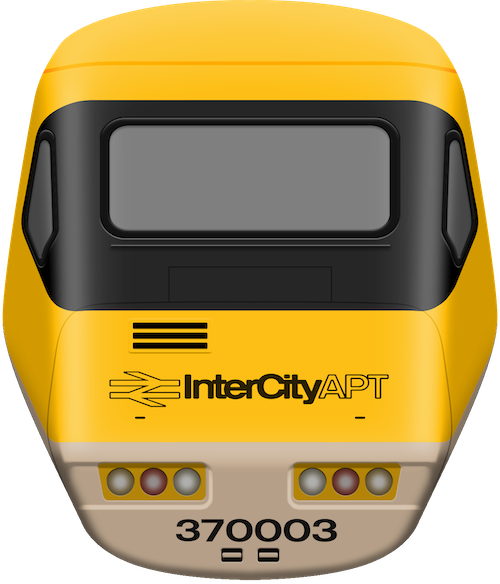

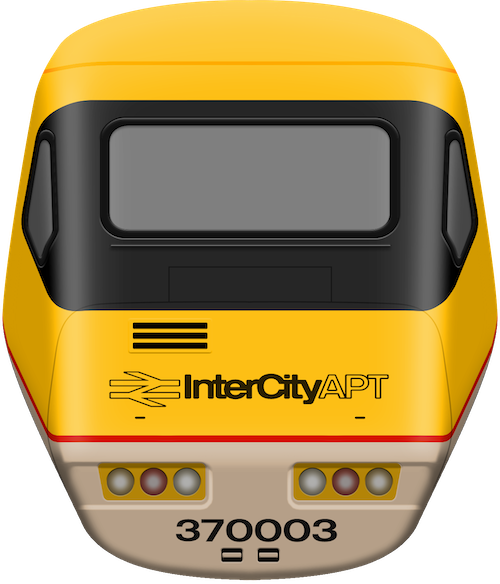
By around August 1985, and certainly by September, 48103 had been fitted with yellow light clusters, replacing the grey ones carried since construction.
Source: Hugh Searle








By mid 1985, attention was focussed on testing the non-articulated converted TS vehicle 48204 in set 370001. 370003 was paired with 370001 from at least August through to March 1986, with a variety of power cars.
Sources: Brian Allen Hugh Searle image series








In January 1986 the pair continued to operate test trains with TS 48204.
Source: Graham Knott



The last change to 48103's appearance came around March 1986 with the application of a red stripe around the nose, in common with the other units retained for the final months of testing.
Source: Silverystreaks / Mark Lumley








By this date 370003 has gained a red stripe around the cab, as applied to all the units that were re-allocated to Crewe during the final year or so of testing.














By November 1987 the pair were the only APT vehicles (aside from non-articulared TS 48204) to survive, and were parked withdrawn at Crewe ETD. Fortunately all seven vehicles can now be found across the tracks at Crewe Heritage Centre.
Source: Hugh Searle
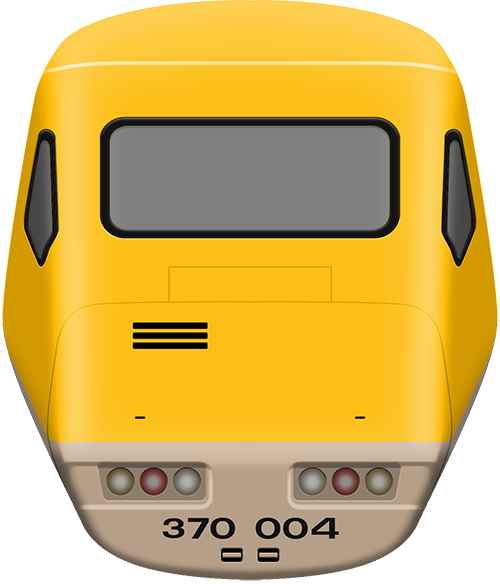

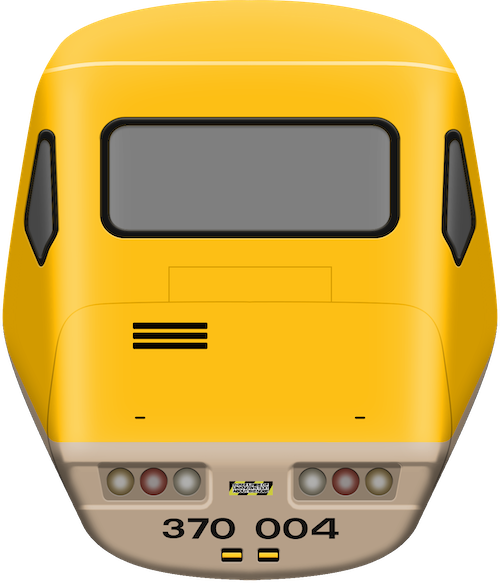
A series of photos illustrating the opening of the APT nose cone provide a view of 48104's first, short-lived face. As with all the other units, a full yellow end is applied, with black window frames. The unit number is vertically centred but very widely spaced and with a wide gap between class number and the sequence number. It may have been hand-painted, given the unusual proportions of the number 4. At this time the nose-opening handles were painted grey.
Source: APT-P.com (apt-p.com)


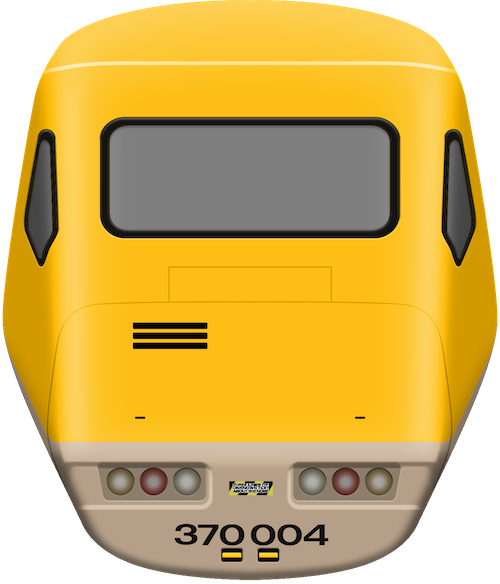
An event at Derby RTC in July 1979 reveals the application of a nose-end sticker, affixed with chevron warning tape, and presumably providing instruction for the correct operation of the nose cone. The nose release handles have now been painted yellow, distinguishing 48104 from the earlier units, which remained grey.
Source: Keith Long






The earliest digital record of 370004 currently available shows the set being hauled by W43000, in around July 1979. The set comprises four trailers with a TRSB as the second vehicle and an unknown TU or TF as the third (48402 and 48502 are included speculatively as vehicles shown allocated to the set in the 1980 RCTS Coaching Stock book). No photos currently allow more specific identification. Interestingly the buffet car appears to have whited-out windows on the kitchen side, a feature not seen on other units. The TBF is assumed to be 48604, as all the units initially ran with correctly paired DTS and TBF cars.
Source: Tony Lower (apt-p.com)


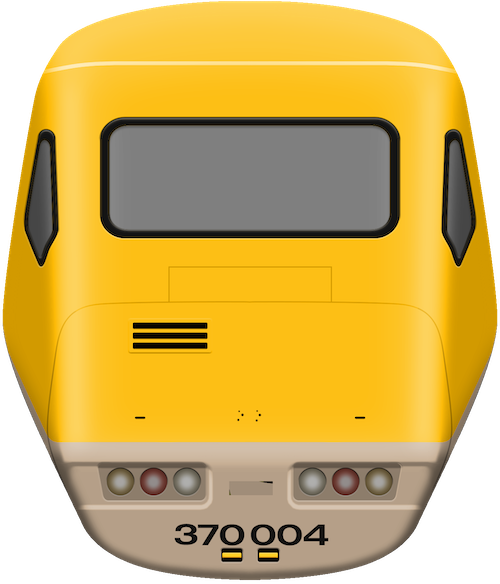
By July, someone had clearly decreed that the unit number was not up to standard, and it had been re-applied in more closely spaced numerals, with a smaller gap between class and sequence numbers, and slightly lower down towards the handles.
Feel free to time-travel back and forth to see the changes by tapping or hovering over the clocks under the cab front image – or compare with other units around the same time by hovering or tapping the cab front graphic.
Source: David Faircloth




The set appeared at Derby Works open day in August 1979. Common to the first four units when new, the buffet and first class vehicles had no above-window stripes applied.
Source: Peter's Rail Pictures


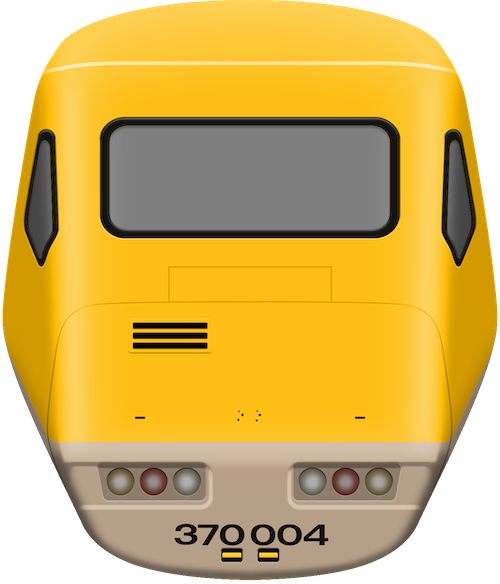
Just over a month later and two minor changes are apparent. The sticker has mostly peeled off leaving a scar (which gradually fades and is eventually cleaned off by April 1980), but several holes have appeared in the middle of the nose at the bottom of the yellow panel, similar to those on 48103, presumably from mounting test equipment in the preceding few weeks.
Source: Gordon Edgar







A month later it also appeared at Crewe Works Open Day on 22nd September complete with unbranded 49005, Test Service Car 9, and W43000.
Sources: Gordon Edgar ee20213 BR Open Days







Reduced to two cars and paired with a four-car 370003 by November 1979, an undated record shows the two sets together with power car 49003 still wearing its wrong-side APT logo. This was rectified by mid 1980.
Source: Andy Beeley







With 49003 replaced by 49001, the set became one of the most photographed APT formations, first recorded from the 004 end in November 1979 (1). This pairing undertook many test runs over the next few months, until June 1980. One notable movement was the pair's participation in the Rainhill Cavalcade on 24th and 25th May 1980, propelled by 56077 (2), following which it immediately returned to testing.
Sources: Hugh Ballantyne nigelmenzies


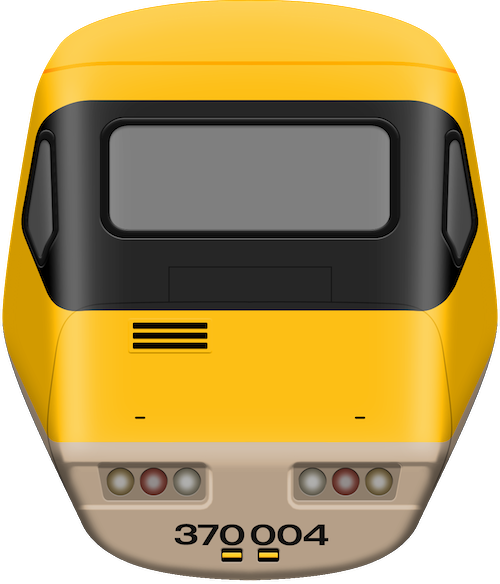
From May, when 48104 became probably the most photographed APT vehicle ever, due to its appearance at the Rainhill Cavalcade, evidence for the sticker had completely vanished, leaving a clean nose end. The holes may later have been treated with filler, but remained visible.
Sometime around 1981, 48104 drops off the digital record as a working unit.
Source: Peter's Rail Pictures








For completeness, here's the propelling formation from the Rainhill Cavalcade.
Source: George Woods







Two separate records dated June 1981 show 370004 paired with four-car 370003, although both of these show the unit in better paint condition than several of the earlier-dated images during its pairing with 001 (see below). Using paint condition as a guide for now, it is hypothesised that these both may actually be June 1980, before 004 took up pantograph test duties. (Additionally, by mid 1981, the four-car 370003 is believed to have been disbanded at Derby, with 48103 noted repainted but still stored in August.)
Sources: David Hancox Robert Gadsdon






The following month the set was paired with the the three car set 370001 and power car 49001, for trials of the first BR Brecknell-Willis High-Speed pantograph fitted to an APT-P (which was initially painted blue, as opposed the grey of all subsequent Brecknell-Willis fitments). What is likely to be the same set was also observed in North Union Yard at Preston in November the same year. During some of the testing period, 49001 was fitted with what appear to be cameras and other equipment to monitor the pantograph's behaviour.
Sources: Neil Smith Dave Felton






Two images dated August 1980 show the same trailer set pairing, but with a regular two-stage Stone-Faiveley fitted power car. At present it's unclear whether this was 49001 with its original pantograph refitted, or another power car standing in temporarily.
Source: George Staddon collection






The same pairing was found parked inside Crewe Carriage Shed circa 1981 (1). A couple of photos suggest 370004 was operating as late as 1982 on the pantograph trials (2), however it's not clear whether these dates are accurate. One such image, dated July 1982, appears to show 004 paired with 370001 (the tilt issues resemble those visible in other photos of the pair in 1980 and 1981). However because by July 1982, set 001 had been refurbished, shortened to two cars and repainted, paired once again with 002, the date on this image is possibly erroneous, and perhaps more likely to be earlier. In addition, the power car was noted inside Derby under overhaul in May 1981, which would seem to preclude continued testing after this date. Nevertheless, for now these are the latest observations of 370004 in operation. It is believed that the unit returned to Derby after this time, but apparently never returned to traffic.
Sources: Peter's Rail Pictures image series Richard Billinge
At the end of November 1982, axle problems forced the withdrawal of all APT-P sets while checks were carried out. Axle rectification and modifications to passenger doors took until May 1983, and it looks like pretty much the whole fleet returned to Derby during this period. As these modifications were taking place, the APT test and development programme as a whole was simplified, and any vehicles not required for the reduced operation were set aside for cannibalisation. One consequence of these changes was that some shuffling of vehicles took place, resulting in 370002, 370005 and 370006 exchanging TBF vehicles.


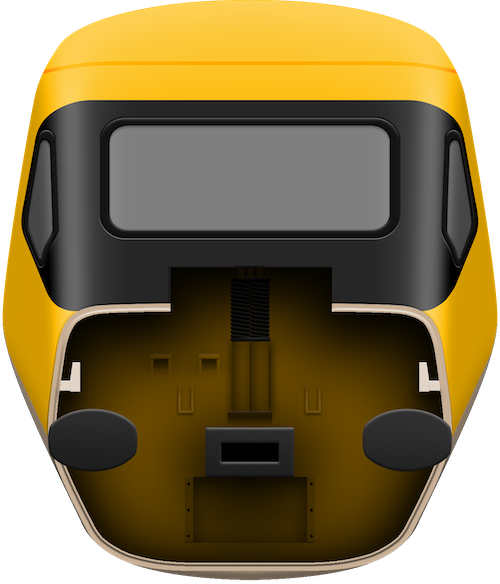
It is presumed that 370004 returned to Derby sometime in late 1980 or early 1981 for overhaul, repainting and extending to full length, pending a return to service, however there are no reliably-dated images of 370004 out on the main line after the end of 1980, and none at all running with a mask. It appears that events overtook BR's plans, and 004 never ventured out from Derby again. One image has come to light of the repainted front end in 1983, with black mask but no logo, while another very small thumbnail image of 48104 in the storage/scrap lines at Derby in 1984 also shows a black mask present around the windows, albeit with no nose cone. Several other images showing 48104 in various stages of scrapping from around 1987 confirm an orange cantrail stripe. This cab front illustration depicts the likely appearance of the vehicle around 1982-1983, with a mask similar in size to 48103. The rain strip is omitted on the assumption that 370004 never returned to operation after repainting and thus was never so fitted.
Sources: Colin Burnham Paul Miller (apt-p.com)






This final formation is something of an oddball. When taken together, a number of images taken in 1983 and 1984 of the storage/scrap lines at Derby show what appears to be a curious formation featuring both the DTS and TBF of 370004. 48604 can be seen articulated with the TF of one of the former full length units sometime in mid-1984 (judging by the presence of a yellow stripe and coach-letter stickers on its door) (1). To the right is another former full-length rake on accommodation bogies, with TF 48504 visible closest (March 1984), suggesting these were the intermediate trailers from 370006 (2). With 370007 still in service, and 370002 not known to have entered public service (thus potentially not receiving coach-letters), it's possible that the vehicle coupled to 48604 is 48505 from 370005. (Also present at the time was the forlorn looking DTS, 48101, which would later return to use on the modified TS test train in 1984, and another unidentified DTS.)
The other ends of these two rakes of intermediate trailers appear to be those visible in an image showing 48104 with a mask on 2nd April 1984, as mentioned above (3) and probably the same as those seen in 1983 (see above). If so, then 370004, despite apparently not returning to the main line after 1981, may ironically have ended up marshalled as a full-length set, albeit only in the storage/scrap lines at Derby.
Sources: Dennis Taylor image series (apt-p.com) Colour Rail 223789 Paul Miller (apt-p.com)



As mentioned above, by around 1984 it appears 48104 lost its nose cone and much of the nose-mounted equipment while stored at Derby. Perhaps the cone found its way onto 48102, which received a replacement in 1984. One final change to the cab end occurred when the whole upper fibreglass window section was removed ahead of final scrapping.
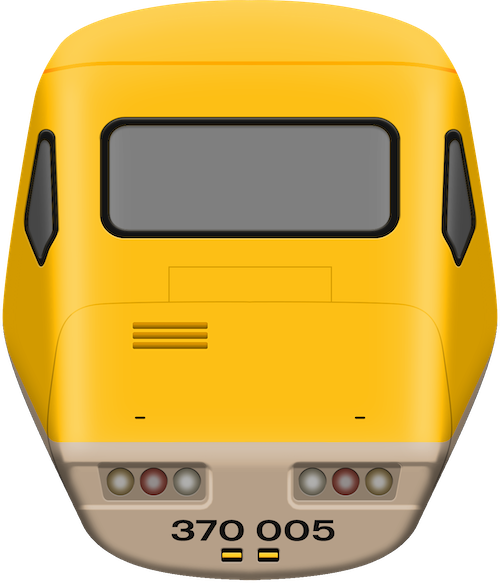

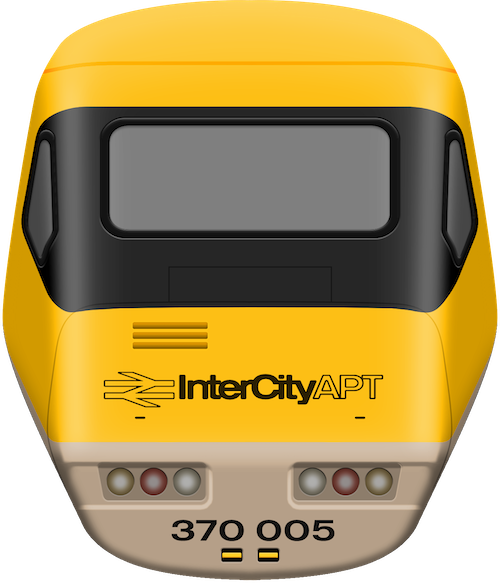
The first photograph available at present shows the cab with a full yellow end, and orange cantrail stripe – sister DTS 48106 is known to have had the white stripe for a very brief time before having it replaced with orange, so it's possible that 48105 was treated the same. However, as seen in the first formation below, 48105 was the recipient of an unusual cant-rail variation in its early days, so it's possible that orange was present from the start. As for the other details, as usual the full yellow end and black window frames are present, the unit number is centred under the lights with a standard gap between class and sequence numbers, and the nose-cone handles are yellow. And for later reference, the small slots above the lights are symmetrically placed.
On 31st October 1979, 48105 was on display at Derby for a visit by Chairman Hua of China, with orange cantrail stripe (albeit applied unusually on the bodyside). 48105 was operating with a full yellow end when it was involved in the high-speed derailment at Yealand, north of Carnforth in April 1980.
48105 was one of two DTS cars that had the horn grille moulding mounted upside down in the nose, compared to all the others, meaning that the flat surface that would normally be the horizontal moulding in the base of each slot instead ended up vertical, blocking the dark interior of the the nose with panels of yellow.
Feel free to time-travel back and forth to see the changes by tapping or hovering over the clocks under the cab front image – or compare with other units around the same time by hovering or tapping the cab front graphic.
Source: Andrew Ronaldson (apt-p.com)




On 31st October 1979, DTS 48105 was at the head of three trailers on display at Derby for a visit by Chairman Hua of China. Vehicle numbers suggest that the TU and TBF may be those later seen in the full length rake, and thus, speculatively the second vehicle may be TS 48203.
Two further APT rakes can be seen beyond 370005, one of which contains TU 48302 – a mysterious vehicle that has, so far, not been identified in any operational or commissioning rakes.
Curiously, 005's DTS features an unusual treatment of the cant-rail stripe, with discontinuous orange stripes visible on the upward sweep of the red and dark grey livery bands. Both are slightly higher than the regular position of the white band above the windows. Additionally it looks like the vehicle was also a test-bed for above-window stripes, as it appears to have a red “catering” stripe above several of the saloon windows. The standard arrangement was in place once in traffic, though it was possible to see the mark where the discontinuous stripe had been removed. 
Source: Andrew Ronaldson (apt-p.com)










370005 had the honour of being the first first full-length half-set to be recorded in operation so far, and the only one known to have done so with the full-yellow driving cab. The consist shown here is likely to be correct as the six-car trailer rakes do not seem to have had articulated trailers swapped around during their operational lives. The earliest current record of 370005 in operation pairs it with 370001 and one power car in April 1980. The pair were undertaking a VIP run from Glasgow on 18th when an axle between TS 48203 and the TRSB of unit 005 failed, derailing at speed near Yealand (1)(3). The train remained upright and was able to be moved to Carnforth. An account is available on the Carnforth Station website (2). Power car 49006 was noted on an RCTS image of the unit prior to the derailment. Of note, the whole rake was fitted with flexible fabric sheets covering the gaps between vehicles. These can often be seen billowing in publicity shots of the train at speed.
Sources: Peter Smith Carnforth Station Allan Hodges (apt-p.com)


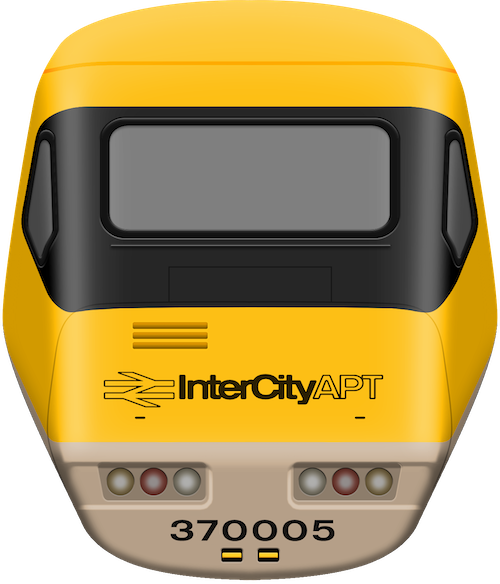
By July 1980, 48105, along with 48106, became the first of the class to receive the wrap-around black window surrounds and APT branding on the nose. The mask extends no more than a couple of inches above the windscreen frame and has noticeable droops to the lower corner curves as the line comes around from the sides, when seen from head on. The lower edge of the mask runs quite close to the top of the nose cone, and no rain strip has been fitted below the windscreen.

Source: Steve Wakefield














Although vehicles were constructed to allow all six units to be formed into six-car half-sets, and run in pairs either side of two power cars, current evidence suggests that this only happened for a very short period. 370005 was paired with full-length 370006 and power cars 49004 and 49002, and ran as a full 14-car set from around July 1980. British Rail made extensive publicity using the full length train, with numerous well-known photos being taken, and helicopter-chase footage filmed along the northern West Coast Main Line.
Sources: BR Andy P. Dave Felton














This formation is tentative and based on a number of linked assumptions. While the date, time and unit 005 are certain, the identity of the second unit is less so. Assumption No.1 is that all six buffet cars had different colour trim, to test public reaction. Assumption No. 2 is that the red buffet car in the series of images of this train's interior is 48406 from unit 370007 (2), while the yellow/orange one is 48401 in unit 005 (1). If these assumptions are sound, this would be the earliest record so far of 370007 in public service, and also the only record of 370005 operating with a full length set other than 370006. To complicate matters, 48404 also had a red trim and at this time was in 370002, so things are by no means certain!
Sources: John Batts (The Transport Treasury) Neil Heaton (apt-p.com)



A rain strip was fitted sometime before the end of 1982, and it looks like the unit number had been reapplied with more evenly spaced digits.
Source: Gary Thornton






After the full-length adventure, 370005 disappears from the digital record for around two years, reappearing as a two car set in late 1982, still with its original TBF 48605. This is, however, the last current sighting with both the original TBF car and its original nose cone!
Source: Gary Thornton
At the end of November 1982, axle problems forced the withdrawal of all APT-P sets while checks were carried out. Axle rectification and modifications to passenger doors took until May 1983, and it looks like pretty much the whole fleet returned to Derby during this period. As these modifications were taking place, the APT test and development programme as a whole was simplified, and any vehicles not required for the reduced operation were set aside for cannibalisation. One consequence of these changes was that some shuffling of vehicles took place, resulting in 370002, 370005 and 370006 exchanging TBF vehicles.



For reasons unknown, from at least 20th May 1983, 48105 was carrying the nose cone previously carried by 48102. Three features give this away: firstly the crudely over-painted '5' of the unit number, with the original '2' still clearly visible beneath it; secondly the asymmetrical slots above the lights that were a unique feature of 48102 shortly after construction; thirdly the slight skew of the APT brand logo previously seen on 48102. A consequence of the change is that the lower edge of the window mask was reshaped, no-longer featuring droops at the lower corners, and running straight across the top of the cone, lower than previously, and almost level with the top of the horn grille frame. A rain strip was also fitted around this time.
Sources: Neville Welling Steve Perryman (Facebook)





In a three-way swap of TBFs, 48105 was paired with 48606, while former 005 TBF 48605 was now with 48102 in 370002. At this time 370005 was paired again with 370006, also shortened to two cars (and now formed of 48106 and 48602), and used for testing.
Source: Antony Guppy






In July the pair was noted with 49002 in place of 49003, but with 49005 added to the formation.
Source: Christopher Wilson






In October 1983 the shortened unit was used for high-speed pantograph and overhead line testing south of Beattock, running at over 150mph on several occasions. Details and photographs of the testing are provided by Dave Coxon on his traintesting.com site.
Source: Dave Coxon






By mid-October the leading power car had been fitted with a roof-mounted pod for observing pantograph motions.
Source: David Chamberlain










In May and June 1984, 370005 was paired with full-length unit 370007, noted at Berkhamsted and Tring on 8th June. An RPS log lists the power cars as 49003 and 49001.
Source: Frank Struben image series





Between January and April 1985, 005 was again paired with another two-car set and a single power car, most likely 370002 which it was noted paired with in May, as the other candidate 370001 was noted at Derby around this time. The set was noted passing Tring on 19th February, and Crewe exactly a month later.
Sources: The Cycling Signalman Kevin Whitehurst





005 and 002 were noted at Preston in May 1985, re-confirming the TBF swap mentioned above.
Source: Simeon Gaskell





370005 was next noted on 11th August on test (1) (almost certainly with 002) before the final currently known appearance of 005 before storage, again with 002 at Wolverton Works Open Day on 17th August 1985 (2).
Sources: Peter O'Brien Gordon Edgar


During 1986, 370005 became a spare parts donor for the remaining active fleet. The last online record of 370005 currently available before it was moved to Derby for scrapping was on 27th February 1987 at Crewe ETD (1), though other sightings show it still present on 28th March(2). It was scrapped in the company of 370001 at Derby later in the year (3).
Sources: Nick Drew Paul Sweetland (correspondence) WesternSunset





In a three-way swap of TBFs, 48105 was paired with 48606, while former 005 TBF 48605 was now with 48102 in 370002. At this time 370005 was paired again with 370006, also shortened to two cars (and now formed of 48106 and 48602), and used for driver training.
Sources: Nick Brown (Facebook) Antony Guppy






In July the pair was noted with 49005 added to the formation.
Source: Christopher Wilson
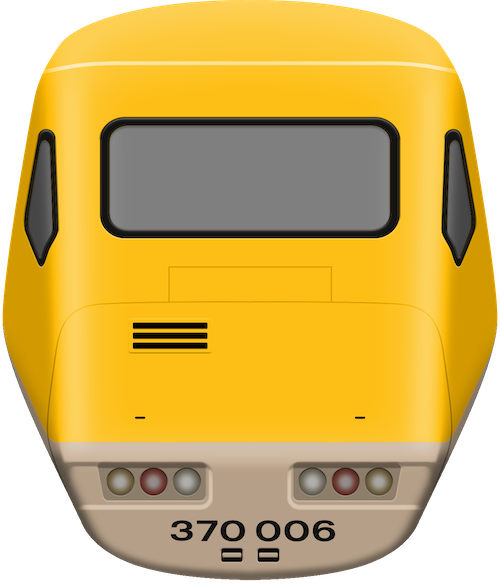

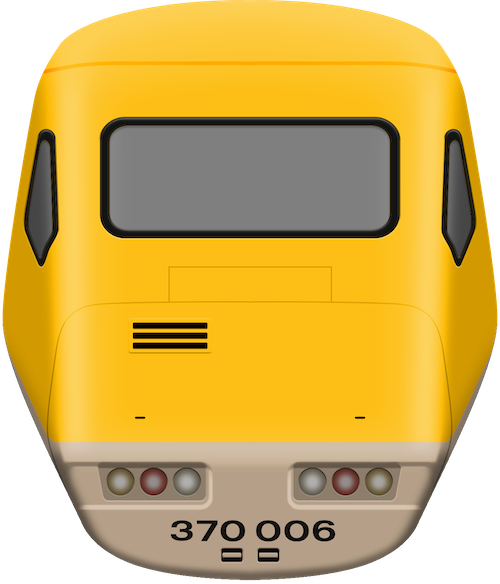
No online images discovered thus far cover the earliest few months of 48106's life, however a printed image at Derby on 18th October 1979, shows the standard 'as new' appearance of full yellow ends, black window frames, and white cantrail stripe. Unit numbers are centred with a standard gap between class and sequence numbers, and the leading 3 slightly smaller and raised a little off line.
Source: C. Burnham, in British Rail Fleet Survey 5: High Speed Trains, by Brian Haresnape (Ian Allan).


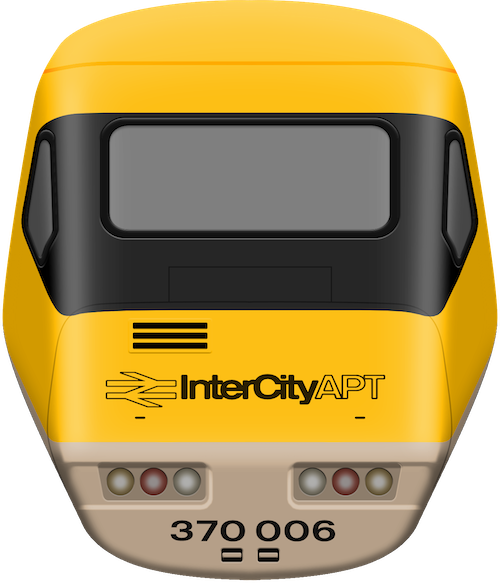
By 27th April 1980, the white cant rail stripe had been replaced by orange. Again, no online images have yet been found covering this period, but one is available in print.
Feel free to time-travel back and forth to see the changes by tapping or hovering over the clocks under the cab front image – or compare with other units around the same time by hovering or tapping the cab front graphic.
Source: Rex Kennedy, in Diesels And Electrics On Shed: Volume Four – Scottish Region (OPC).


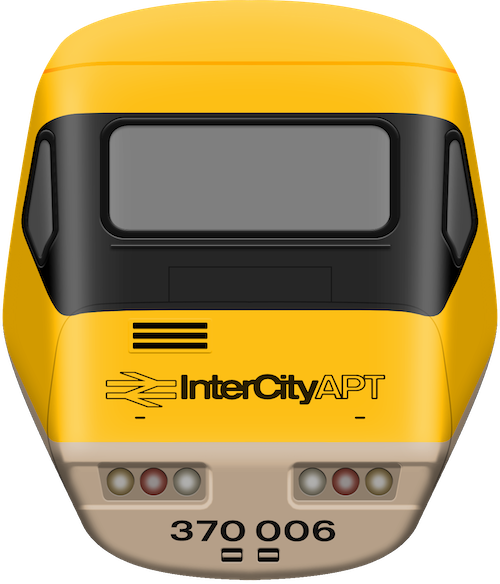
By July 1980, 48106, along with 48105, became the first of the class to receive the wrap-around black window surrounds and APT branding on the nose. On 48106 the mask goes no higher than the top of the windscreen frame, making it the lowest of the seven. The bottom corner curves have noticeable droops as the line comes around from the sides, when seen from head on. The lower edge of the mask runs parallel to the top of the nose cone section, but a little further from it than seen on 48105. No rain strip has been fitted below the windscreen.

Source: Dave Felton














370006 was the second full-length rake to see operation. Although vehicles were constructed to allow all six units to be formed into six-car half-sets, and run in pairs either side of with two power cars, current evidence suggests that this only happened for a very short period. 370006 was paired with full-length 370005 and power cars 49002 and 49004, and ran as a full 14-car set from around July 1980 (1)(3). British Rail made extensive publicity using the full length train, with numerous well-known photos being taken, and helicopter-chase footage filmed along the northern WCML (2). Of note, the whole rake was fitted with flexible fabric sheets covering the gaps between vehicles. These can often be seen billowing in publicity shots of the train at speed.
Sources: Dave Felton BR Andy P. image series









006 next makes an appearance at Glasgow Works open day in June 1981 (1), with motive power for the move provided in at least one direction by 37125 (2).
Sources: Bruce Galloway Sandy Clark (upcoming publication)














Following the open day appearance, it was partnered with the third full-length rake, 370007 in July 1981.
Source: Max Fowler (apt-p.com)













The following month 006 and 007 were paired with a single power car.
Sources: Dave Felton Dave Felton









In October 1981 006 was paired with power car 49006 and 370001 and noted at Preston on 23rd and 29th. Additionally this set is featured in the BBC Horizon documentary 'Race Against Time' broadcast in December 1981 which charts the unit between 19th and 23rd October (with thanks to Adrian Wheeler for the tip-off!).
Sources: British Rail 1980s and 1990s Vincent


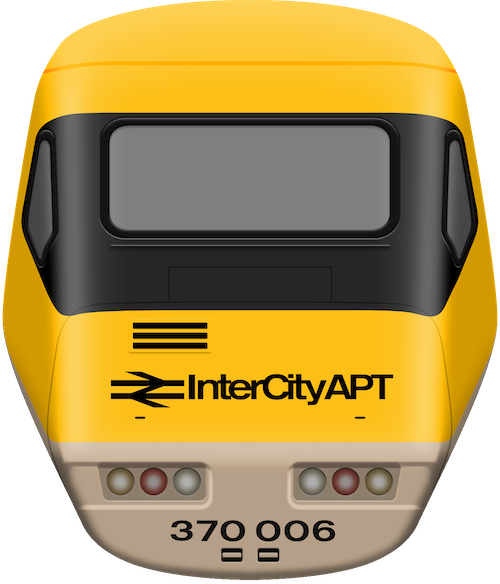
The rain strip appears by 1st December 1981, having not been present on October 29th.
Sources: Getty Images Vincent










In December 370006 became the centre of media attention, along with two-car 370002 and two power cars, forming the official first passenger carrying APT-P service.
Source: 74009












Unfortunately some seriously bad weather over the next couple of days brought the network to a halt, with the APT's southbound run on 9th December being curtailed at Crewe. A couple of days later, the set was recorded heading north with a Class 40 for traction, but with 85006 on the back, pantograph raised, apparently providing brake force.
Source: Alan Taylor (private Facebook group)










Over the next several months 006 and 002 remained paired, with a variety of power car combinations. The pair were noted at Hest Bank unusually with the frontmost pantograph raised.
Source: RailPhotoPrints image series










An undated record shows 006 with what's very likely to be 370002 sometime in 1982 (judging by the relatively good state of 48106's paintwork), but with a Brecknell-Willis pantograph-fitted power car in the formation.
Source: Antony Guppy










In early June the power cars were again Stone-Faiveley-fitted.
Source: robertcwp









Between June and August the pair were noted with a single power car in the shape of 49003.
Source: Antony Guppy










October saw the set with 002 once again, now reformed with two power cars, with 49003 now fitted with a Brecknell-Willis high-speed pantograph.
Sources: steam60163 Andrew McConnell
At the end of November 1982, axle problems forced the withdrawal of all APT-P sets while checks were carried out. Axle rectification and modifications to passenger doors took until May 1983, and it looks like pretty much the whole fleet returned to Derby during this period. As these modifications were taking place, the APT test and development programme as a whole was simplified, and any vehicles not required for the reduced operation were set aside for cannibalisation. One consequence of these changes was that some shuffling of vehicles took place, resulting in 370002, 370005 and 370006 exchanging TBF vehicles.









The last known movement of 370006 as a full six-car rake is a move from Glasgow Shields Road to Derby, via the Settle-Carlisle line, over 16/17th March 1983. Haulage was a Class 40.
Source: Paul Colbeck (apt-p.com)





Less than two months later 370006 was running as a two-car set, now with TBF 48602 from 370002 in place of the original 48606, and sighted at Cheddington (1) with a single power car and another unidentified two car set on 13th May. This TBF swap led to some confusing unit renumbering, as seen below!
Source: John Glover, in Modern Locomotives Illustrated No. 167 by Colin J. Marsden


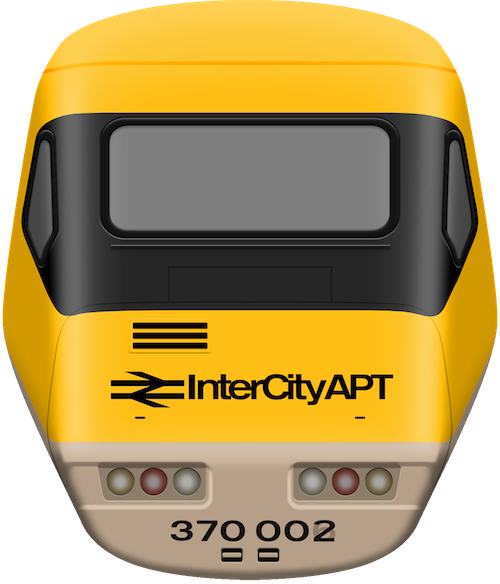
By 18th May 1983, the APT logo on the front of 48106 was starting to look somewhat flaky. Consequently the front end was repainted, but it seems that the stores were running short of APT logo vinyls. Instead it appears an all-black imitation logo was crafted from standard solid Rail Alphabet characters, artfully overlapped in a similar style to the logo, but without the rounded corners and outline BR arrows and “APT”. This alteration, and in particular the black double-arrow, were unique to 48106.

Source: Nick Brown


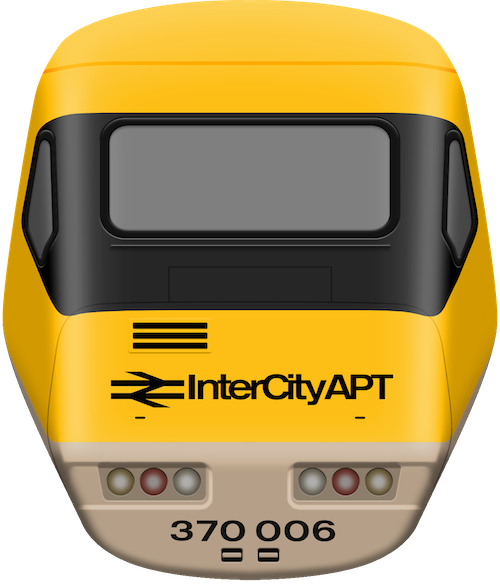
In June 1983 things get complicated as 48106 gained the unit number 370002 courtesy of a hand-painted '2' over the still clearly visible '6'. The unit number change is thought to have been the result of the recent swapping of TBF cars between this unit, 370002 and 370005, with 48106 being paired with 48602. As the convention was to number electric multiple units after their brake vehicles, it's hypothesised that this occurred with 48106. However both 48102 and 48105 returned to traffic retaining their 002 and 005 unit numbers respectively, despite the mis-matched TBFs, and 48106 regained the unit number 370006 after a few weeks, while retaining TBF 48602.
Source: Antony Guppy


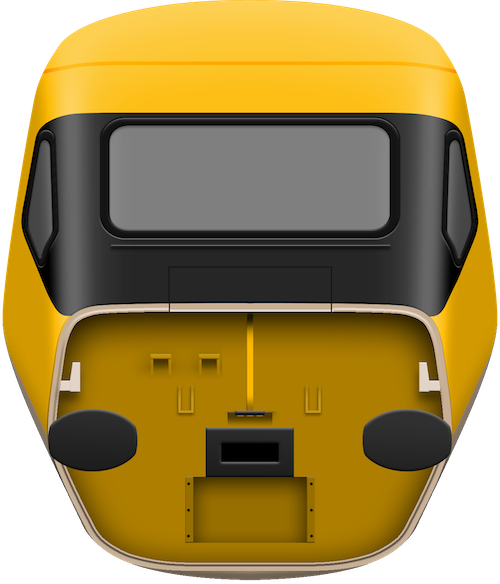
By 11th August 1983, after only a few weeks running as 370002, 48106 had reverted to carrying 370006, though was still paired with TBF 48602 – perhaps in the case of the APT, operating staff preferred the unit numbers to reflect the driving car.
Source: Dave Coxon


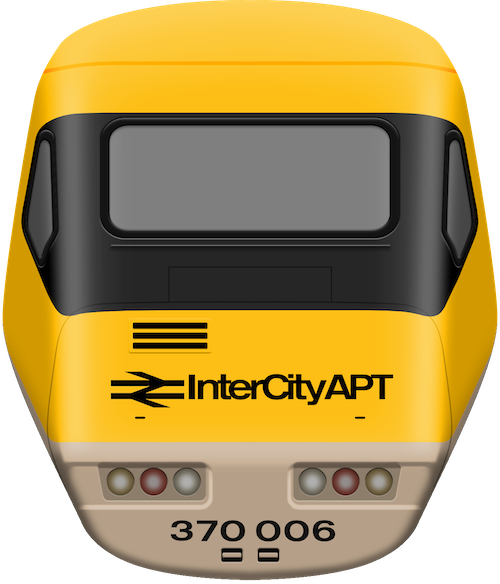
For a few weeks in July and early August 1984, 48106 took part in coasting trials on the East Coast Main Line, during which time its nose cone was removed entirely.
Source: Ian Britton (apt-p.com)


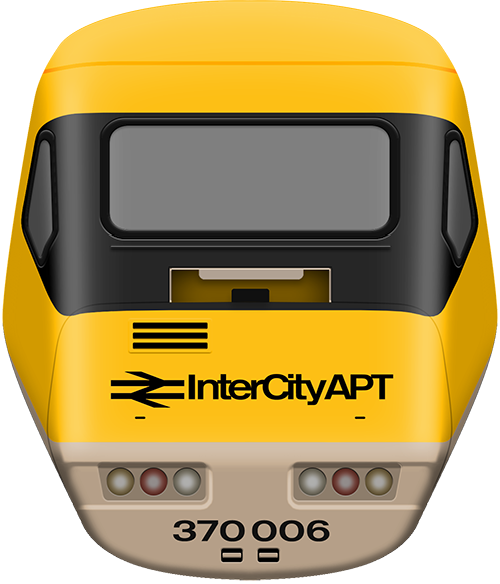
48106's nose cone was re-fitted after the ECML coasting trials ahead of its return to public service.
Source: Haydon Walker


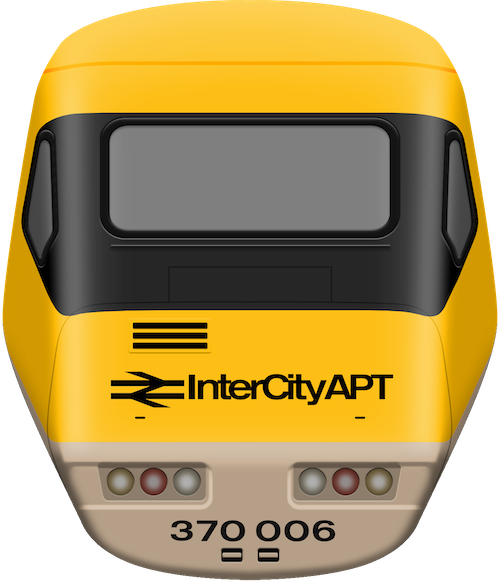
A one day special? On 22nd August, 1984, 48106 was missing the upper flap of its nose cone, creating an unsightly hole, and no doubt some aerodynamic inefficiencies!
Source: spannerman37025


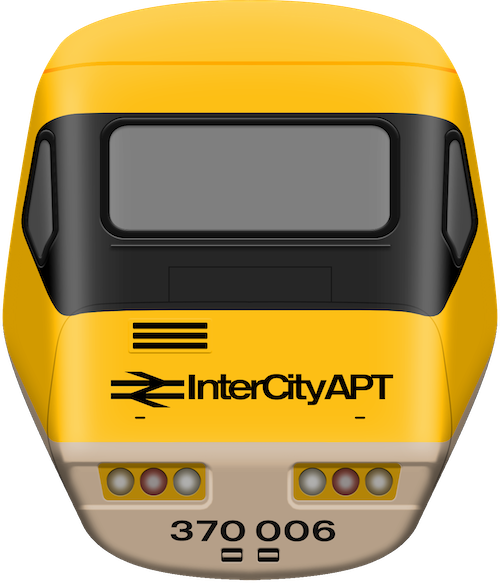
Within a couple of days the missing flap had been replaced.
Source: Hugh Searle


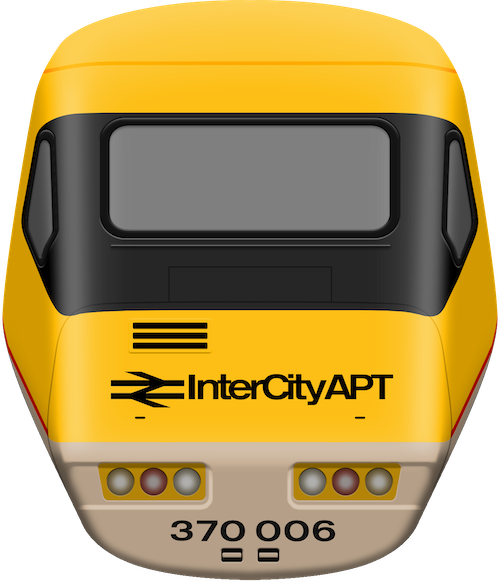
370006 drops off the digital record for nearly 12 months, but by the end of November 1985 48106 had received yellow light clusters in place of the previous grey.
Source: Paul Williams


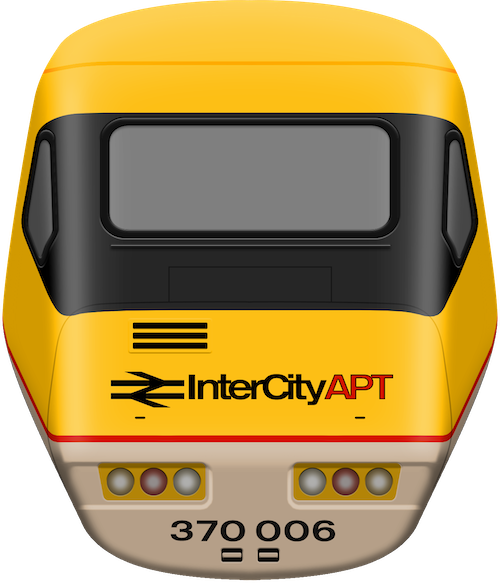
A possibly very short-lived variation as 48106 returned to use on test trains – it appears that the depot staff at Crewe started to add their trademark red stripe while the unit had its nose cone raised, and didn't have time to finish the job before the set was pressed into use. Other images from February show the vehicle without the stripe, but with a general smartening up by July.
Source: Peter



The temporary half-striped finish was replaced in 1986 by a fresh coat of paint on the yellow ends, and a red infill on the 'APT', similar to that carried by 48101.

Source: 28years






From July 1983 the pair (with 006 back as 006 from at least August 11th!) was reformed with two power cars, making a very powerful short set. This formation was put to use on high-speed pantograph and overhead line testing work south of Beattock during October, running at over 150mph on several occasions. Dave Coxon provides details and photographs of the testing on traintesting.com (1). The same unit was also noted at other locations (2).
Sources: Dave Coxon Simeon Gaskell






Shortly after the high speed tests, and missing one power car, the pair visited Thornaby for tyre turning, hauled by 37101.
Sources: Neville Stead John Wyldbore (apt-p.com)










During March and April 1984, 006 was paired once again with full-length 370007 in preparation for a quiet return to public service. Noted on 16th March at Euston, power cars were 49003 and 49006.
Sources: Keith Long Haydon Walker









For a short period around the start of April, the same pair ran with just 49003 as power. Though undated, cross-referencing the front-end bird-strikes, paint chips and other weathering details suggest a date of early April.
Source: first-class-rail

Not really a formation as such, but perhaps inspiration for a modelling project: 48205, previously in 370006, already missing doors and half its seats, spotted on road transport near Northampton in May 1984. Where was it going, and what for? A comment on Facebook mentions an APT car that was delivered to a design company in Letchworth for use in seat design development! One and the same?
Source: G H Taylor










An interesting event took place over a three week period from 16th July 1984 when 370006 was again paired with 370007 and hauled to Heaton depot in Newcastle for overnight braking trials on the non-electrified East Coast Main Line where the set was propelled up to 100mph and released. Also present at Heaton for the trials was 370003. Arriving with two power cars (1), the pair was also noted on depot with 49003 removed (2), and also split into separate sets during the period. Notably, 48106's nose cone appears to have been removed for the duration of the trials.
Sources: Brian Grey RobT653









An undated record shows what appears to be two Class 37s propelling 370006, two power cars, and 370003, suggesting that various formations were operated during the trials.
Source: Norman Skinner (apt-p.com)











A further undated record appears to shows the 006/007 combination with a single power car being propelled by the 37s.
Source: Ian Britton (apt-p.com)










During August 1984 the Heaton pair resumed public service between Glasgow and London, together with 49001 and 49003. The set was noted in use on 17th August (1), where it encountered 370001/370002 at Preston, and again at Carlisle on 17th September (2).
Sources: Haydon Walker Dave McDigital










Well, here it is – the reason this page was created. On 22nd August 1984 I caught this train from Preston to London and back, formed of a two-car 370006 with a hole in its nose, the first-built power car, the named power car, and a full-length trailer rake that included the spare coaches of 370007 and had its horn grille plated over. Now I guess it's time to build that OO-gauge model!
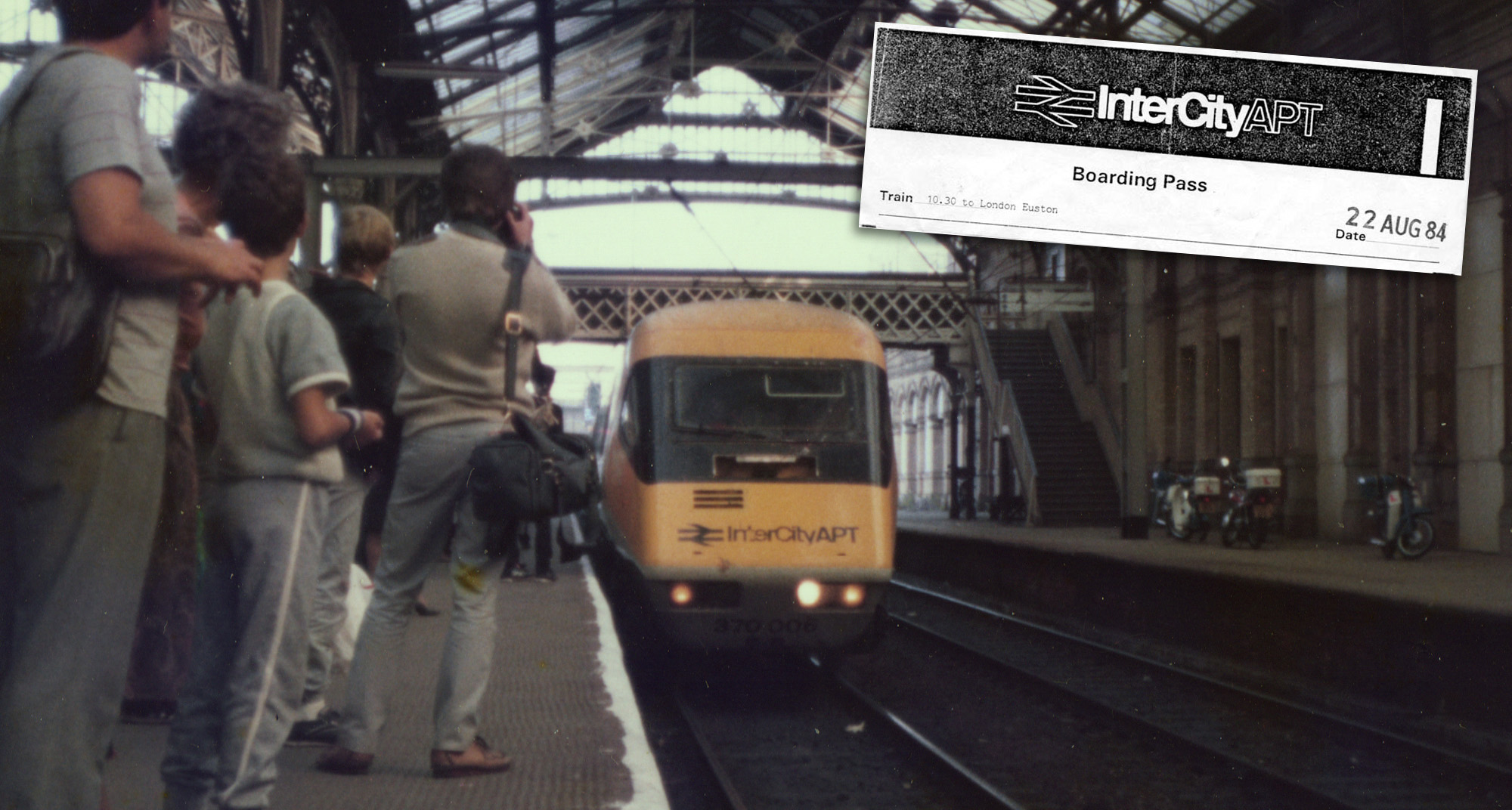
More from the same day: spannerman37025










By November 49006 had replaced 49003 (the date has been estimated from the condition of the two DTS cars, cross-referenced with other dated photos).
Source: Keith Till (apt-p.com)










By mid December, 49003 had returned to the rake, displacing 49001, with both 49003 and 49006 receiving Shields Road "leaping salmon" emblems. These were retained until the end of APT operations from the Glasgow depot in late 1985. On 12th December, this set broke the London-Glasgow speed record, completing the northbound run in 3 hours, 52 minutes and 40 seconds. This record still stands in 2023.
Source: John Tolson





By November 1985, 370006 was stored at Crewe ETD. The leftmost unit in the first source photo on 30th November is believed to be 370006, back-to-back with an unknown power car and two car set, which by process of elimination is likely to be 370005, with 370002 on the right.
Source: Hugh Searle


On the same day after some shunting the set was parked separated from the other unit. The set remained stored at Crewe until early 1986 when it would get a further lease of life.
Sources: Paul Williams Simeon Gaskell






Sometime around March or April 1986 370006 returned to action paired with the non-articulated TS 48204 and 370001.
Source: Peter







From at least July to September 1986, 370006 and three-car 370003 became the final APT formation in operation. Of note, the TBF 48602 lost its yellow first-class stripe again around this time, returning to its original condition.
Sources: dubdee Tiptree Jon 28years







By November 1987 the pair were the only APT vehicles (aside from non-articulated TS 48204 at Derby) to survive, and were parked withdrawn at Crewe ETD. Fortunately all seven vehicles can now be found across the tracks at Crewe Heritage Centre.
Source: Hugh Searle
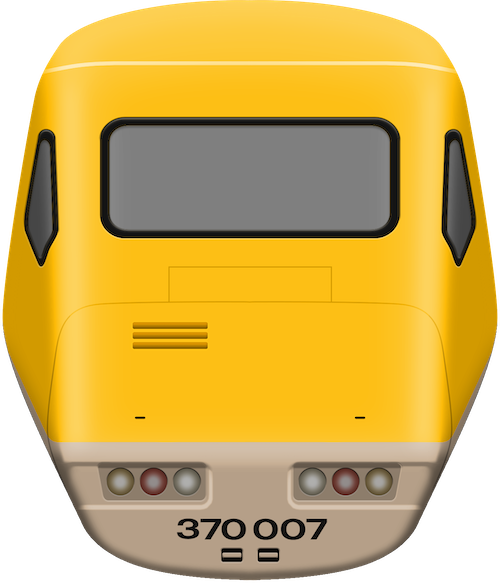

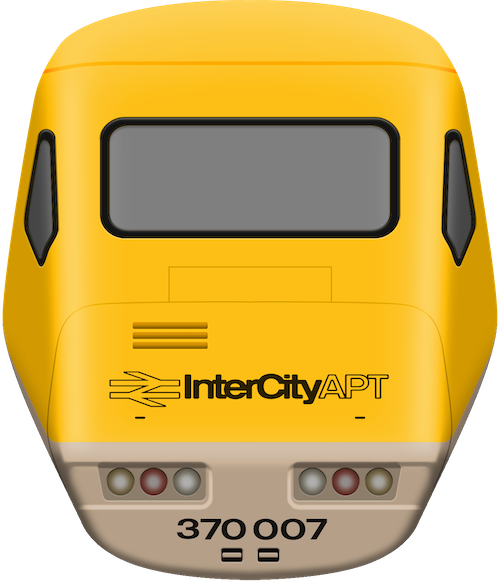
Like the main fleet, the supposed 'spare' DTS, 48107, began with a full yellow end, black window frames, and white cantrail stripe. The unit number appears to be in the slightly heavier version of Rail Alphabet and, like many of the other units, appears to have been hand painted. 48107 was the second of two DTS cars that had the horn grille moulding mounted upside down in the nose, compared to all the DTS vehicles, meaning that the flat surface that would normally be the horizontal moulding in the base of each slot instead ended up vertical, blocking the dark interior of the nose with panels of yellow.
Source: Rail-Online


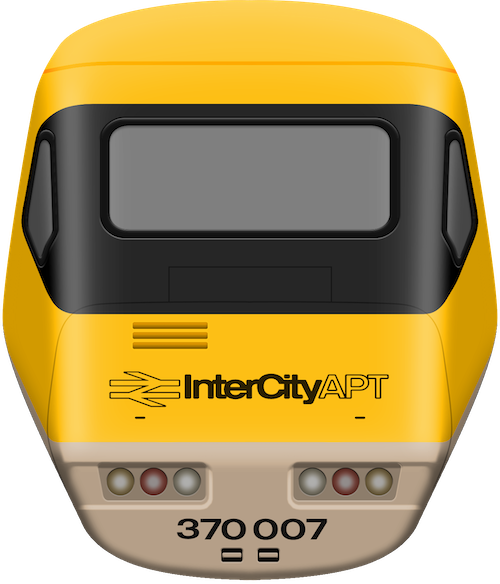
In addition to quickly gaining an orange cantrail stripe 48107 was the recipient of a unique livery variation for a short time in 1980, when it received the standard APT brand logo in black on the nose, but without the associated black mask window surrounds. With this appearance it attended a Fellowship of Engineering event at the London Transport depot in Ruislip.
Feel free to time-travel back and forth to see the changes by tapping or hovering over the clocks under the cab front image – or compare with other units around the same time by hovering or tapping the cab front graphic.

Sources: Martin Higginson, in British Electric Trains In Camera by Brian Glover (Ian Allan) Nick








On 9th July 1980 the Fellowship of Engineering held an event at the London Transport depot in Ruislip. 370007, formed as a full six car set with intermediate trailers from a variety of other intended units, was in attendance. According to a report in APT: A Promise Unfulfilled by Hugh Williams, it was hauled to and from the event by a HST power car from 253020, however other reports of the unit's travel to the Underground depot have the motive power somewhat more mundane, in the form of a Class 47 outbound and Class 25 return (below). 007 was the third full-length unit formed, and uniquely remained a six car set all the way to the scrapyard in 1986 – a possible irony, considering that the DTS and TBF were built as spares! Of note, the whole rake was fitted with flexible fabric sheets covering the gaps between vehicles, but these appear to have been removed by mid-1981.
Source: David Coles (apt-p.com)
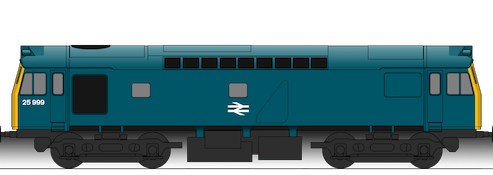







The return move from Ruislip LT depot was in the hands of a Class 25.
Sources: Nick Stephen Fisher (apt-p.com)


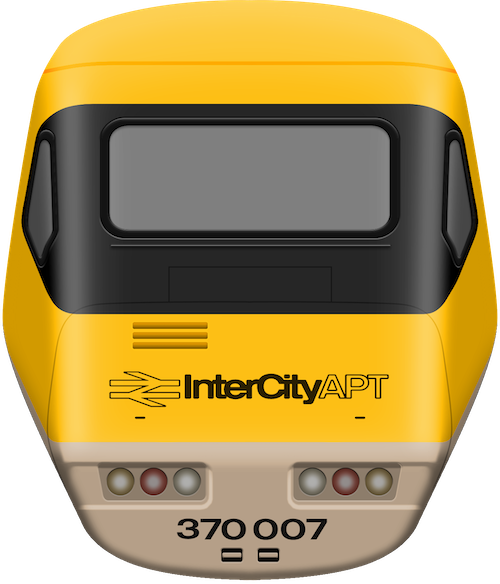
Continuing its exhibition role, 48107 next appeared at Derby Works open day in September 1980, now with full mask applied. This extended above the windscreen by a few inches – slightly more than 48105, and about the same as 48102. The lower edge curves in smoothly from the sides, without lower corner droops, and runs almost straight across the top of the nose cone, not curving slightly to parallel the top of the section as on 48105 and 48106.
Source: Gary Thornton






Shortly afterwards, and with the addition of black window surrounds, the new set also attended Derby Works open day on 6th September.
Source: Haydon Walker














The first known operation of 370007 was noted in July 1981, paired with the six-car 370006 and two power cars while on test in the Abington area. (There is tentative evidence to suggest the set operated on passenger-evaluation runs in December 1980 - see entry with 370005 above.)
Source: Max Fowler (apt-p.com)













The following month 007 and 006 were recorded as a low-powered 13-car set with just a single power car.
Source: Dave Felton









In the run up to the public launch of services 370007 was paired with a two-car 370001 and power car 49002 (1). On 20th September the same pair appeared at Old Oak Common open day (2).
Sources: Frank Struben Paul Rowlatt (apt-p.com)









There is not a lot of photographic coverage of the unit In 1982, but on at least two occasions around this period, 007 was again paired with a single power car and an unidentified two-car set. The presence of a dark smudge on the roof of the rear TBF suggests the two car set may be 370001, as this car uniquely had an exhaust port for an auxiliary diesel generator.
Source: Richard Hugo


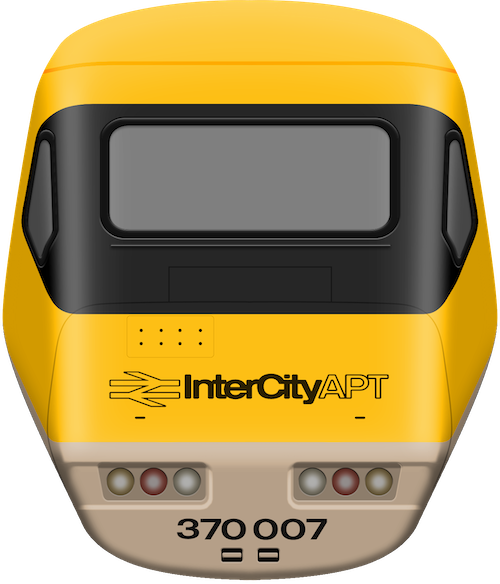
Some time before the end of July 1982, the rain strip was added below the windscreen wiper.
Source: Haydon Walker









A similar set was noted on 30th July 1982.
Source: Haydon Walker









Sometime in the summer of 1982 (going by vegetation, paint chips and other tell-tale signs), 370002 was paired with 370007, and pictured in the Wembley area.
Sources: Neil Heaton (apt-p.com) Diesel Image Gallery (apt-p.com)
At the end of November 1982, axle problems forced the withdrawal of all APT-P sets while checks were carried out. Axle rectification and modifications to passenger doors took until May 1983, and it looks like pretty much the whole fleet returned to Derby during this period. As these modifications were taking place, the APT test and development programme as a whole was simplified, and any vehicles not required for the reduced operation were set aside for cannibalisation. One consequence of these changes was that some shuffling of vehicles took place, resulting in 370002, 370005 and 370006 exchanging TBF vehicles.










The only current record of activity in 1983 shows the set paired with a two car unit and (probably) two power cars.
Source: Steve C Boreham










While 1983 is sparsely represented in online digital evidence, 1984 was to be 370007's big year, as the only full-length set in operation. Paired with a shortened and reformed 370006, the unit was used from March on proving runs ahead of a re-entry to public service.
Sources: Keith Long Haydon Walker Tony Woof


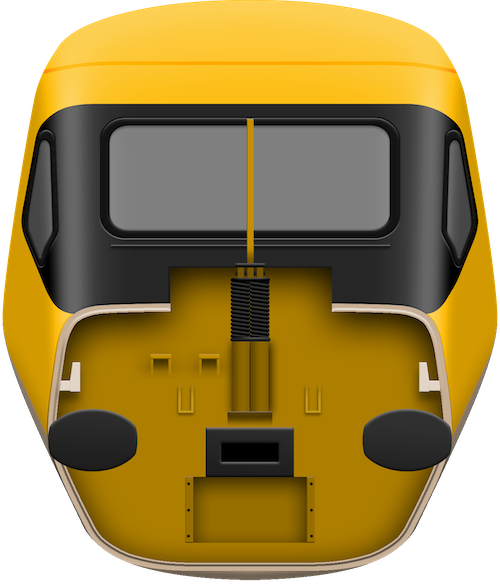
The final change to 48107's appearance was the replacement of the horn grille with a rivetted panel with eight holes in it, similar to 48102's temporary five-holed panel. This was a distinguishing feature of 48107 for the remainder of its operational life.
Source: Keith Long







86217 was spotted shunting unit 007 at Shields Road – a very rare instance of an AC electric coupled to a Class 370!
Source: Haydon Walker









Though undated, cross-referencing the front-end paint chips, bird-strikes and other weathering details suggest a date of early April for an image of 370007 and 370006 running with 49003 as sole traction.
Source: first-class-rail










From May to early June the set was paired with shortened and re-formed 370005.
Sources: Frank Struben Bill Watson










An interesting event took place over three weeks from 16th July 1984 when 370007 was again paired with 370006 and hauled to Heaton depot in Newcastle for overnight braking trials on the unelectrified East Coast Main Line where the set was propelled up to 100mph and released. Also present at Heaton was 370003. The complete set arrived with two power cars.
Source: Brian Grey









The pair was also noted on depot with 49003 removed.
Source: RobT653







It was also split into a half-rake while stabled.
Source: Colin Anderson collection











An undated record appears to shows the 007/006 combination with a single power car being propelled by the 37s.
Source: Ian Britton (apt-p.com)












One more from the ECML propelling tests, noted with 37132 and 37250, and what looks like both power cars between 370007 and 370006.
Source: Peter Robinson










Following the ECML foray, 007 and 006 returned to passenger service in August and September 1984, operating a relief Glasgow-London service. Power cars were reported as 49001 and 49003. It was noted, for example, at Preston on 17th August (1), alongside 370002/370001 on a test train, and again at Euston on 24th (2).
Sources: Haydon Walker NightRail










Well, here it is – the reason this page was created. On 22nd August 1984 I caught this train from Preston to London and back, formed of a two-car 370006 with a hole in its nose, the first-built power car, the named power car, and a full-length trailer rake that included the spare coaches of 370007 and had its horn grille plated over. And for completeness, the northbound run was undertaken with the frontmost pantograph raised. Now I guess it's time to build that OO-gauge model!

More from the same day: spannerman37025 74009










By November 49006 had replaced 49003 (the date has been estimated from the condition of the two DTS cars, cross-referenced with other dated photos).
Source: Keith Till (apt-p.com)










By mid December, 49003 had returned to the rake, displacing 49001, with both 49003 and 49006 receiving Shields Road "leaping salmon" emblems. These were retained until the end of APT operations from the Glasgow depot in late 1985. On 12th December, this set broke the London-Glasgow speed record, completing the northbound run in 3 hours, 52 minutes and 40 seconds. This record still stands in 2023.
Sources: John Tolson Leo Pomfret










On 3rd February 1985, full-length 370007 and three-car 370003, together with power car 49003 were recorded at Thornaby. Of the source photos, the left hand image seems to be of the formation described, while the right one appears to show a two-car set, so is likely to have been a different occasion.
Source: John Wyldbore (apt-p.com)











The same pairing, with 49006 re-added to the rake, continued to be operational during March through May 1985. On 3rd March it ran to Finnieston via Glasgow Central Low Level in connection with the opening of the Scottish Exhibition Centre (1). The set was also noted at Wolverton on 1st April (2), and at Glasgow Central on 3rd May (3). The latest photo evidence currently available of 370007 in operation is on 17th May.
Sources: spannerman37025 Haydon Walker Haydon Walker



A final indignity for 48107 was the loss of its nose cone in late 1985. While 48107 later moved to Rotherham for scrapping in 1986, the nose cone remained dumped in the grass at Crewe Electric, being sighted there as late as March 1987 (thanks to Paul Sweetland for this nugget!).
Source: Haydon Walker






Following withdrawal earlier in 1985, 370007 was stored at Crewe ETD and stripped for spares. Minus its nose cone, the six car rake remained intact and numerous photos online show it stored on the depot. DTS 48107 was recorded in a somewhat dilapidated state on 16th November.
Source: Haydon Walker










The final formation was an incongruous pairing with two-car 370002 and power cars 49001 and a now nameless 49003 (both facing the same way) for a one-way trip to Rotherham for scrapping. The formation was noted at Tinsley on its last journey. Thanks to Paul Sweetland for a correction on this formation!
Source: Nigel Curtis (apt-p.com)






Sticking together to the end, 370007 was dismantled still in its six-car formation at C.F.Booth during July and August 1986.
Source: Hugh Searle
Some photos have come to light with unidentified units in interesting formations - here are a handful!
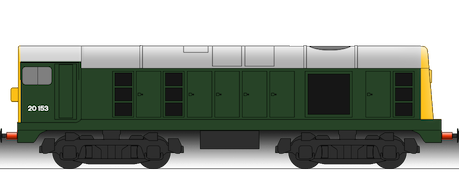


Another prototype for everything! An unidentified TBF on accommodation bogies shunted at its articulated end by green liveried 20153 and a blue grey BG barrier vehicle.
Source: Chris Nuthall









Spotted at Derby in early 1979, going by the date, it's possible that the set was 370003 in its 5-car commissioning formation, however only a few vehicles are visible in the photo.
Source: Garry Brookes
At the end of November 1982, axle problems forced the withdrawal of all APT-P sets while checks were carried out. Axle rectification and modifications to passenger doors took until May 1983, and it looks like pretty much the whole fleet returned to Derby during this period. As these modifications were taking place, the APT test and development programme as a whole was simplified, and any vehicles not required for the reduced operation were set aside for cannibalisation. One consequence of these changes was that some shuffling of vehicles took place, resulting in 370002, 370005 and 370006 exchanging TBF vehicles.










On an unknown date in 1982 or 1983, 45065 was caught hauling a pair of units sandwiching 49003 through Stoke. The formation of the rear unit is not visible, so this is speculatively shown as a full length set based on known formations involving 49003 during that period. Unfortunately neither set is identifiable.
Source: Simon Lilley





A transit move heading for Crewe from Derby with an unknown two car set, and Test Service Car 11 acting as the adaptor vehicle.
Source: Nick Allsop





Another transit move with 49006 being hauled through Durham by 31311 with Test Service Car 9 and the elusive and rarely photographed Test Service Car 12 (plus a brake van) as adaptors.
Source: R Kitching



The otherwise apparently unused TU vehicle 48301 appears to have found a role as a static tilt test vehicle at Derby RTC, according to a spotting book from around 1984. One 1987 photo of Test Service Car 11 shows a random articulated trailer in the background which may well be this car.
Source: Colin Marsden
This first group of vehicles do not appear anywhere in the operational formations listed above - at least not yet. While there are several trailer vehicles that remain to be confirmed above, such as two of the intermediates in 370003's five car commissioning rake, it looks likely that one or two of those on the left were never actually formed as part of a working unit. Additionally the second group shows trailers that appear to have been formed into rakes for commissioning, but have not yet been identified in operational unit pairs.
A note from a spotting book circa 1984 indicates that otherwise unused TU 48301 was used at Derby RTC as a static tilt test vehicle. It also appears to have been scrapped on site there.























































If you find an old photo of an otherwise unidentifiable APT and would like to figure out what it was you saw, here's a rough guide as to your likely spot, based on the findings above. This is not a definitive list - just some of the more frequently photographed sets. See above for more details.
Note that formations with two power cars occasionally were reduced to one power car. Formations marked 3* feature the non-articulated TS 48204 between the TBF and power car. Sets are shown with the longest unit on the left, with set numbers corresponding to the illustrations.















































































































































Quick and dirty rules of thumb for the most likely units operating in pairs:
Which units worked with which? Based on the known formations listed above, the following operational combinations are currently confirmed:
For those interested in prototypical modelling of the APT, the following may be of use, given the currently available vehicles and their variants. Obviously it's possible that some of the following may eventually be disproved, but it currently appears that:











The following formations illustrate some of the weird and wonderful APT-P related test trains for which there is a photographic or other record. These include power-car test trains, formations involving Lab 4 "Hastings", Lab 8 "Pilot", or Lab 24 "Trestrol". There are undoubtedly others that went unrecorded, or which have not yet been discovered. Some modelling inspiration perhaps.




Lab 24 'Trestrol' was, as its name suggests, a converted Trestrol wagon mounted on two prototype power bogies and fitted with the anti-tilt pantograph mechanism that would feature on the power cars. It was used for ride and gauge testing, as well as to prove the anti-tilt gear.
Source: traintesting.com





Source: Dave Stacy






Source: D.R. Vickers / 53A Models





One of the earliest power car test trains featured 49001, which appeared to carry a paler, bluer shade of grey on the upper body band, with a less saturated light grey.
Source: Martyn Hilbert





Source: Dallam Dave





Source: Peter Spilsbury (apt-p.com)






Source: Phil Bancroft (apt-p.com)





Source: Dallam Dave





Source: Stewart Warrington






Lab 8 'Pilot' was a test vehicle constructed from the prototype APT-P trailer body shell. It operated between the two APT-E PoP-Train vehicles, PC3 and PC4, which were themselves instrumental in the development of tilt systems.
Source: apt-p.com (apt-p.com)






The same rake as above, different 86, seen further south.
Source: N. Johnston in APT: A Promise Unfulfilled, Hugh Williams (Ian Allan)





Source: Peter Spilsbury (apt-p.com)








Another view of 49003's notable livery variation spotted on a test run in August 1980 with the APT logo on the side normally reserved for the BR arrow.
Source: Graham Williams




Sources: Stapleton Road Roger Sutcliffe





Source: Kevin Lane





Sources: Dave Felton The Transport Treasury






Source: Chris Fletcher






Source: F. Cheevers







Source: traintesting.com




Source: Dave Felton






Source: traintesting.com





Source: Arnie Furness







Lab 4 'Hastings' was a narrow-bodied former Hastings Line buffet car converted from a paint store to a tilt test vehicle. It contained a 'lounge' area of seating and double-glazed windows believed to have been rescued from a former Blue Pullman unit.
Source: Lewis Bevan







Source: Dave Felton






By 1982, Lab 8 'Pilot' had been fitted with windows on both sides – two in the centre of both sides; see below for the other side.
Source: Vincent












An APT-adjacent test train running to test the effectiveness of current collection at high-speed with pantographs raised at both the front and rear of a train (fitted to Lab 1 and Lab 6). This was primarily to assess the concept of an electric version of the HST as well as APT-U and APT-V proposals (see 'What If?' below), with two pantographs raised, thus avoiding a 25kV bus-bar along the whole train (the reason the APT had central power cars). In addition to Labs 1 and 6, the train was formed of two HST power cars, two HST TGS cars, and six redundant HST TRUK kitchen cars.
Source: Traintesting.com











A shorter version with 7 HST trailers was also run as part of the above testing.
Source: Traintesting.com






On 2nd July 1982, now-preserved Class 81, 81002 was in charge of the PoP train plus Pilot. An image taken at Crewe shows the revised window arrangement on the other side of Pilot, with two central window openings and the far left one made.
Sources: Andrew Salmon (apt-p.com) Barney Staples






Source: Dave Bowman






Source: John Whitby (apt-p.com)









Notes
The utilisation tables are approximate and certainly incomplete, with periods based on formation sighting dates from the main lists above (power car identification is particularly incomplete). Introduction dates are used as an approximation of build dates, which are currently unavailable, though many vehicles were built and occasionally operated months ahead of official introduction or acceptance dates.
"Unpaired/Test" denotes either: trailer vehicles in half-sets observed on commissioning runs with HST power cars, or on display, etc., not paired with another half-set; power cars running in test trains without other Class 370 trailer vehicles.
"In Traffic" denotes either: trailer vehicles in normal operation within paired half-sets; power cars in normal operation between two Class 370 half-sets. (Shorter periods out of traffic are not shown.)
Sources:
"British Rail Coaching Stock 1980", RCTS, 1980
"British Rail Coaching Stock 1981", RCTS, 1981
"British Multiple Units: Volume 3, Classes 302-390", Ashley Butlin, Coorlea, 2001
"Modern Locomotives Illustrated, No. 167, Blue Pullman Stock & The APT Fleet", Colin J. Marsden (Ed.), The Railway Centre.com, 2009
With additions and modifications from photographic sources shown above.
British Rail Coaching Stock 1980 and 1981 (RCTS) list official allocations of APT vehicles to units as at the end of 1979 and 1980 respectively, as well as those vehicles accepted for traffic. For example, at the end of 1979, 370001 is shown allocated vehicles 48101, 48206, 48405, 48303, 48505 and 48601, but of those only 48101, 48206 and 48601 were in traffic (conforming with 370001's 3-car formation at the time). With hindsight, we know that 370001 never ran as more than a three-car set: 48206 was later removed, 48303 ended up in 370007, 48505 in 370005, and 48405 is not currently known to have run in any set. However, vehicles noted as allocated to units 003 and 004 that were also listed as accepted to traffic do match some of the vehicles identified in early photos of these rakes, prior to being shortened into their operational formations.
It's worth noting that other intended vehicle-to-set end-1979 allocations did not come to pass - new units 005, 006, and 007 appear in early to mid 1980, and 002 is extended to full-length, with mostly different formations to those indicated. The first table lists the RCTS end-of-1979 allocations with the vehicles believed to be present in the units at the time marked in bold, and the units to which vehicles were ultimately allocated shown alongside, where different (as currently understood). Of note is 48401, present in 370003 in 1979, which was removed from the set and reformed in 370005 by mid-1980.
The end-1980 allocations are closer to those seen in traffic, but again not fully concordant. The second table lists the RCTS end-of-1980 allocations with the vehicles believed to be present in the units marked in bold, and the units in which vehicles were actually present shown alongside, where different (as currently understood). As can be seen, the allocations are closer to the observed formations than the late-1979 list, but with a handful of swapped allocations apparent. Of note is the allocation of 48404 to 370003 - this car was in 002 at the time, but later did become part of a three-car 370003. It's also possible to extrapolate that the full-length 370007 was taking the place of an anticipated full-length 370001, given that three of the four trailers allocated to 001 were present in 007 at the time.
Finally, this table lists all trailers in idealised numerical sequence but with the actual set numbers shown alongside, for easy cross-reference. As can be seen, only three intermediate trailers ever operated in their numerically "correct" formations. The three TBF vehicles which later swapped to other units are also shown.
As introduced, all APT vehicles carried the "Sc" prefix to indicate their Scottish Region allocation to Shields Road depot in Glasgow.
As for the power cars:




































































One curiosity of the fleet was the variety of internal colour schemes used on the buffet cars. The trim in each was finished in a different shade for evaluation purposes, and while no official records have so far come to light, a handful of online photos suggest the following colours.
The colours shown are picked from colour-corrected (as best as possible) photos found around the internet and in official publications. Many of these were taken with flash, and so a wide range of colour is recorded in individual photos. In these I've attempted to pick the most likely "average" colour to give a representation of the trim colour, but colour reproduction is subject to many vagaries!
A BR publication shows the green buffet - my personal hunch is that this was 48402, believed to have been formed briefly in TR4 (370004) but removed before the set entered traffic. However it could equally be 48405, which has not yet been noted in any formation.
The sixth colour remains unknown at present!
Here are some of the APT formations that never happened, plus some proposed, speculative or just plain fantasy ideas. Maybe given a few more years we'd have seen Class 370s in service, rebranded in INTERCITY 'Swallow' livery, or perhaps the APT-S might have followed with a more conventional single power car. We will never know!





Never Happened #1 It's perhaps surprising that this traditional 5-car 'Hornby' formation does not seem to have ever run with full-yellow ends! Only 370004 is currently known to have run as a two-car set without a mask.














Never Happened #2 (probably) Another surprise, perhaps, is that no 14-car pair seems to have run with full yellow ends. 370005 did run paired with three-car 370001 without a mask, but so far that is the only known occasion on which a full-length half-rake operated with the full yellow end.














Never Happened #3 Subtle one, this: the first four units did not initially carry above-window stripes to indicate first class or buffet facilities, however none were initially full length sets. All four full length units had stripes applied either from new, or when extended to full length, making this blank formation (or even half of it) entirely fantasy, if somewhat neater!







APT-P Proposed Formations #1 (1971) Hey, what's a gas turbine doing here?! Well, since this site deals with the APT-P it's probably worth including the fact that in 1971 the plan was to build two APT-P sets by around 1974, one gas-turbine powered, and one electric powered. The formations were to be either M+5+M or M+8+M - so perhaps a five-trailered APT-P resembling APT-E is not too far-fetched!










APT-P Proposed Formations #2 (1971) Here's how the electric APT-P set might have looked under the 1971 proposals as an 8-car formation. No details are available as to the trailer designations, but airline-style catering was definitely an option being seriously considered (see below). To that end, in this illustration, no buffet car is included, but some cars have a seating bay removed to provide space for a galley for trolley service.
Source: APT The Untold Story by David Clough (Ian Allan)
















APT-P Proposed Formations #3 (1972) By 1972 all the plans had changed, and BR was looking at a bizarre M+6+M+M+6+M formation of two half-sets with two power cars each. Four electric and two gas turbine APT-Ps were approved. Issues surrounding power collection for four power cars had apparently not been at the forefront of anyone's consideration at this stage. Again it's not clear how the trailers would have been organised, so this illustration has a proportionate mix of first and second class in both half-rakes, again with galley service assumed.
Source: APT The Untold Story by David Clough (Ian Allan)














APT-P Proposed Formations #4 (1973) By 1973 everything had changed again. Gas turbines were no longer flavour of the month, and potential current collection issues had finally come to the fore, resulting in the plan to place two power cars centrally between two trailer rakes. BR's commercial division decreed that first class would be on one side of the power cars, and second class on the other. 1+11 (125mph max), 2+12 (155mph - the longest train that could be accommodated in existing stations and depot facilities) and 2+14 formations were proposed. The 2+14 proposal was in response to a contemporary study that suggested patronage on the London-Glasgow route would increase significantly, and would have required platform lengthening among other infrastructure upgrades. This illustration is an interpretation of the 2+12 formation, based on documents found by Rob Latham at APT-P.com, which appeared to include a First Kitchen, but at the second class end alternating S and SG vehicles. As mentioned above, the 'G' represented a 'galley', possibly with a view to airliner-style, at-seat service to avoid having passengers in the aisles too much on a tilting train! While this class-separated arrangement makes some practical sense, given the power-car location in the middle of the train, it's understandable that identical half-rakes were eventually built, if only to minimise the number of vehicle designs required, and maximise interchangeability. Indeed, by 1974 the identical rake idea had superseded this divided-class plan.
Sources: APT The Untold Story by David Clough (Ian Allan) APT-P.com (apt-p.com)
















APT-P Proposed Formations #5 (1974-ish) Had traffic increased to the levels anticipated the 2+14 formation may have become a reality. This illustration shows a 14+2 rake and the styling is based on a 1970s model of the APT-P following redesign of the cab areas to better suit a double-manned driving cab.
Source: Modern Locomotives Illustrated No. 167 by Colin J. Marsden














APT-P Proposed Formations #6 (1976-ish) Several spotting books from the late 1970s and early 1980s list APT TS vehicles as numbered 48201-48212 or in two series as 48201-48206 and 48301-48306. Indeed, several official documents show the 2+12 formations as being formed with two TS cars and no TU between the buffet and first class. The numerical sequence of trailer vehicles as built would also make more sense with the 483XX series as a second class trailer between the 482XX and 484XX series vehicles, so it does seem like the option to include two restaurant cars in place of 140-odd additional second class seats was a late amendment.






Proposed Test Loco #1 (1972) Apparently D832 was acquired by the Research Division with the intention of fitting an APT-P traction motor and power bogie (plus pantograph and transformer – non-tilting, one assumes!) for testing in about 1972. The result would have been a distinctly peculiar vehicle! In the event D832 was used more generally by the RTC for a period before ending up in preservation.
Source: APT The Untold Story by David Clough (Ian Allan)


Proposed New Test Train (1975) A new high-speed test train to develop novel concepts, drawing on the experience of APT-E, was proposed in 1975. Functions would include research on electrical systems such as tubular induction motors, energy storage systems, acoustics and suspension, tilt and pantograph development, braking systems etc. The proposal would have seen the train be formed of two APT-P-style vehicles, called variously Pilot 1 and 2, or TC3 and 4. Pilot 1 would be converted from the prototype APT-P trailer bodyshell (“Pilot”) rebuilt with a P-train style driving cab, modular power equipment (exchangeable between electric, diesel and “energy conservation” modules), induction motors on its axles and equipment racks. Pilot 2 (also known as the “Quiet Vehicle”) would be a new build vehicle fitted out at one end with seating, and a Maybach diesel power pack scavenged from D832 at the cab end. The vehicles and bogies would be developed and tested in conjunction with the existing PoP train, but then operated independently as an articulated pair from 1977.
The Pilot 1 diesel module would have used the second engine from D832; its electric module was initially planned to use similarly rated Class 313 power equipment. Maximum speed with two diesel engines powering induction motors on all six axles was anticipated to be up to 155 mph, while up to 186 mph was proposed for dynamic pantograph testing with uprated power equipment.
Source: BR documents from the Brian Porter collection











Production Series APT-S (1978) As the prototype units were being assembled, thoughts turned to the squadron series of APTs, known as APT-S. The initial proposal was for a fully-articulated version formed of a single power car at one end, with ten trailers including a DVT. 43 of these sets were to be introducted on the WCML from 1984 (and more for the ECML from 1986).
Sources: APT The Untold Story by David Clough (Ian Allan) BR Press Release, November 1981 (apt-p.com)








Production Series APT-Q (1978) In addition to the 43 APT-S trains, the existing APT-P units would be split into six units using the new-build DVT design at the power car end.
Sources: APT The Untold Story by David Clough (Ian Allan) APT-P.com (apt-p.com)












Production Series APT-R (1981) By 1981 delays to testing on APT-P and thus to the design of APT-S led to a further proposal aimed at speeding the introduction of APT. This would have seen further new trailers and power cars built to the same basic design as APT-P, but with a new-build driving cars at each end. This would be similar in concept to, and compatible with, the APT-Q, with new-design DVT plus an 'Auxiliary' driving trailer to complete the rake at the power car end. 20 of these sets were proposed, with a further 34 APT-S to follow.
Sources: APT The Untold Story by David Clough (Ian Allan) BR Press Release, November 1981 (apt-p.com)












Production Series APT-T (1982) In the constantly changing APT world, next up was an APT-T in which the auxiliary driving vehicle had a powered bogie for better performance. Ultimately the split of design resources and the idea of small fleets of differing designs saw the R and T trains abandoned.
Sources: APT The Untold Story by David Clough (Ian Allan) BR Press Release, November 1981 (apt-p.com)












Production Series APT-U (1982) Alongside APT-T, APT-U was proposed, with power cars at either end and ten intermediate non-articulated trailers. This proposal won out over the various articulated designs, and in due course, articulated trailer 48204 was modified to run as a non-articulated trailer to test the concept ahead of fleet production. Some 17 U-trains were initially proposed, mostly for London to the North-West. After trials with dual-pantograph test trains at high speeds (see Test Trains, above) the problems associated with current collection from dual raised pantographs were expected to be resolved.
Source: APT The Untold Story by David Clough (Ian Allan)












Production Series APT-V (1982) But we're not done yet! The long lead time in developing a lightweight tilting power car with driving cab led to an additional proposal - the same trailers as APT-U, but with an electric version of the HST power car (non-tilting) for traction, as a stop-gap until new APT power cars were developed. Four initial power cars, also capable of working with up to 11 Mk3 coaches, were authorised.
Of course, by 1983 everything had changed again and two power cars were no-longer considered financially viable for the WCML - thoughts turned to a single 140mph loco that could be used on InterCity and other work, with tilting trailers ... and with a rebranding to 'InterCity 225', the rest is history.
Source: APT The Untold Story by David Clough (Ian Allan)





Flights of Fancy #1 Instead of the prototype HSTs, perhaps some other pointy traction could have been put to use testing the Power Cars.







Flights of Fancy #1.5 Maybe with a couple of TCs thrown in for extra load.











Flights of Fancy #2 A fantasy formation with a single power car and reformed Class 370 trailers. This formation actually uses up the entire fleet of unmodified APT-P trailer second vehicles!














Flights of Fancy #3 How a full-length Class 370 might have looked in InterCity Swallow livery - a liberty taken here is the extension of white along the whole train, instead of limiting it to cabs/power cars, indicating the APT's status as a premier train  and echoing the white look of very high speed stock in Germany and Japan.
and echoing the white look of very high speed stock in Germany and Japan.











Flights of Fancy #4 "Whiter Swallow" on a single power-car set.













Flights of Fancy #5 Some serious fantasy-land test-train-ing going on here. 370001 regains its original test car 48206, with "Pilot" added to the formation, non-articulated 48204 stuck on the outside, and every other tilting or APT-esque vehicle that Derby could find thrown in for good measure. Plus an HST power car to slowly drag the whole lot to and from base.






Flights of Fancy #6 Repainting "Pilot" and 48204 into the later RTC livery, because why not?







Flights of Fancy #7 If they'd pulled the gas-turbines out in 1976, and built a few more trailers...
















Flights of Fancy #8 APT's articulation, with two bogie pivots per bogie, always seemed a little odd to me. Perhaps if BR had opted for a more conventional articulation arrangement with shorter overall vehicle lengths, we'd have seen something a bit more like this.










Flights of Fancy #9 Shorter bodies and end power-cars, TGV-style!
APT-P.com - A wealth of information and photographic resources on the Class 370, without which this page would not have been possible.
traintesting.com - Excellent behind-the-scenes information about the various periods of testing with APT-P units, on and off the main line.
Crewe Heritage Centre - The home of the remaining APT-P vehicles next to the West Coast Main Line in Crewe.
APT-E.org - The APT-E Conservation & Support Group, restoring the predecessor to the APT-P at NRM Shildon.
Old-Dalby.com - More from behind the scenes during the testing of the APT-E (broken link in 2024).
Railtec Models - Transfers for detailing all your APT models!

Email me with corrections, clarifications, contradictions, and compliments!  New information always gratefully accepted.
New information always gratefully accepted.
As bits of the APT puzzle came together in the making of this page, I would occasionally be taken aback by a new and unexpected discovery. One such discovery was spotting a thumbnail on traintesting.com which showed a fully masked-and-branded six-car rake being hauled near Toton in 1980. On opening the larger image and discovering it was 370002 - which until that point I'd never come across as more than a three-car set - suddenly my whole picture was thrown out! This was a fourth full-length rake that I'd not previously been aware of, and which clearly didn't last very long in traffic given its invisibility thus far. How long did it last? Why are there no other photos? What were the individual vehicle numbers?
Then I noticed photos of 002 at Crewe Works Open Day in 1981 - was it the same full length set? Almost all the photos I found online only showed the DTS and a portion of the next vehicle - so I couldn't immediately tell. I searched the internet for works open day listings, and came up with nought. I found more photos of the set at Crewe - again no-one listing more than the DTS.
It was clearly going to be a mystery. But then I thought to myself ... didn't I actually go to that open day in 1981, when I was 8? Had my dad taken any photos? Well yes, he had, and 370002 was definitely a six-car set, because there it is, right behind me!
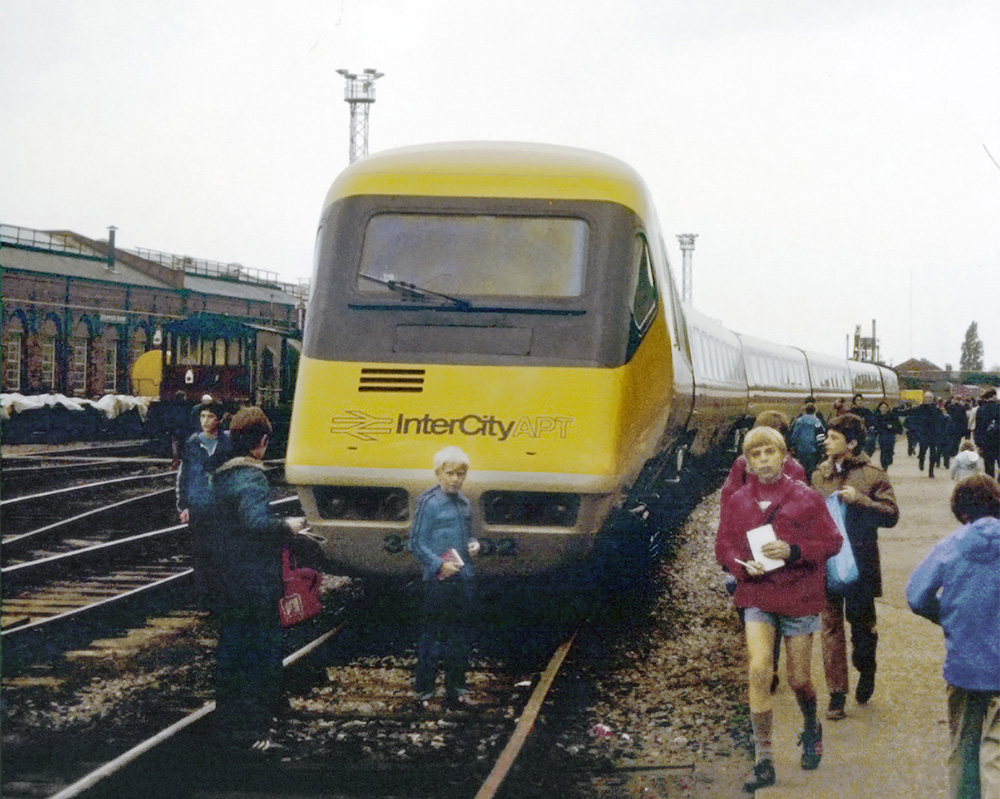
And I bet I wrote the vehicle numbers down in that book I'm clutching - but the chances of me still having a notebook from 1981 were pretty much zero. Turns out that was indeed the case. So after leaving the mystery unsolved for a month or two, I did another random internet search, this time using obscure APT trailer vehicle numbers, and came across a number of references to the RCTS Coaching Stock book from 1980, which APT modellers were referring to for official vehicle allocations. Although these didn't fully correlate with observed formations, I knew I had a copy of the same book in the attic, and went digging to find out exactly what information it contained. When I opened it, I could barely believe what I found.

8 year old me had come home from Crewe Works, and actually underlined the vehicles he'd seen (plus a couple each from 001 and 004 which were running around as a pair at the time - and neither of those sets were full length). As 002 was the only six-car set I'd seen up close thus far, the underlines were almost certainly the set from Crewe. And assuming I didn't write the numbers down incorrectly, or somehow underline the wrong vehicles ... mystery solved! Or at least advanced somewhat. Sometimes the answers are much closer to home than one might expect!
An additional silver lining was that the RCTS data in the book also gave me a lead on the earlier longer formations of 003 and 004, before they were paired up, by correlating the 1979 vehicle allocations, the list of vehicles accepted into traffic, and formations observed in photographs. Thus some of the unknown vehicles in those sets have now been tentatively identified.
Now we just need some more photos to confirm or refute all of this!
1500V DC APT-P
© 2022-2025, O. Hodgson